APO Recipients
Fellow (FAP)
(Introduced 1994)
Dr Ian McMahon Fellow of the Australian Philatelic Order
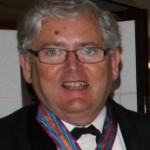
Since Dr McMahon received the award of MAP in 2010, he has not rested on his laurels regarding his commitment to philately. This citation highlights his commitment with a selection of achievements from his extensive Philatelic CV.
1. Services to Organised Philately
Dr McMahon has been President of the Philatelic Society of Canberra (PSC) since 2010 (in addition to his service before 2010) and has been President of the ACT Philatelic Council since 2002. In 2017 he was made a Fellow of the Royal Philatelic Society of London.
During the last two years of the COVID pandemic, Dr McMahon was an early adopter of technology for ensuring meetings and presentations continued across a range of organisations. He embraced online exhibitions and encouraged exhibitors to participate in these. He has been tireless in running Zoom meetings, and assisting those less skilled in IT technology, for PSC Council and display evenings, ACT Philatelic Council, the PSC Postcard Group, the Postal Stationery Society of Australasia, and the Australian Philatelic Federation (APF).
Dr McMahon is an ongoing member of many years of six Australian philatelic societies and another eight overseas societies. His record with the APF shows he has contributed to various roles since 1996, including President, Immediate Past President, Vice-President, Philatelic Development Officer (twice), and currently holds the position of Secretary (since 2015) – his second term in this position.
He has also been Acting Chairman of the FIP Postal Stationery Commission since 2019, Secretary 2012-18, Bureau member 2001 to date and Australian representative since 2006.
2. Exhibiting and Judging
Dr McMahon has an established record of exhibiting nationally and internationally across six classes achieving several Gold level awards. His major interest and successes are those of Postal Stationery especially of Canada, New Zealand, and modern Australia. He has exhibited at International Level in Postal Stationery (to Gold), Literature (to Vermeil), Revenue (to Gold), Postal History (to Vermeil), and has also exhibited in Postcards, Traditional and Open Philately classes.
Having qualified as a judge before 2010 at State level, National level, Postal Stationery with FIAP and FIP level, Dr McMahon has continued to serve on many juries at exhibitions including Australia and New Zealand, as Jury Chair or Secretary, as well as serving as Secretary-General of the FIP exhibition, Australia 2013, and the
FIAP exhibition, Melbourne 2017. In February 2022 he served on the jury at London 2022.
Dr McMahon has served on the Organising Committees of most of the Canberra biennial Stamp Shows since the 1980s and continues to assist with training courses for new exhibitors and judges at all levels of competitive philately.
3. Research and Publications
Dr McMahon has been a prolific contributor to a range of Australian and international journals since 1987. His publications have also ranged from scholarship such as archival research on early Queensland railway postal rates, to APF informational brochures. His current bibliography of nearly 300 published articles presents a substantial increase since 2010 with a range of new knowledge.
In 2015 Dr McMahon received the Research Award of the Australian Commonwealth Collectors’ Club, and his article in Revenue Journal the same year was voted Best Article. He has written a monthly column in Stamp News which is ongoing, and earlier for the Australian Stamp Monthly. These cover postal stationery, postal history, revenue, and railway stamps.
As a leader within the Postal Stationery field, Dr McMahon is Editor of The Postal Stationery Collector, a role he has held since 1995. His promotion of scholarship in this field resulted in a Vermeil award for the journal at international level. He has also been the Editor of the FIP Postal Stationery Commission Newsletter since 2018, and an Editorial Committee member of Capital Philately, the journal of the PSC, since 1989. His monograph Listing of Non-Denominational Postal Stationery of Australia was published in 2016.
Gary Brown Honorary Fellow of the Australian Philatelic Order
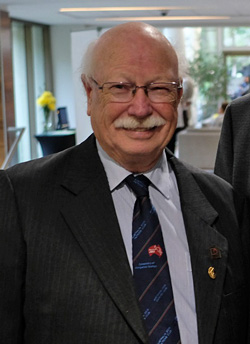
Gary Brown has been one of the leaders of Australian Philately with enormous achievements both Nationally and Internationally. As a collector, exhibitor, International Judge, mentor, trainer, manager of International exhibitions, member and leader of philatelic societies and innumerable other roles, Gary’s contribution to organised philately was huge.
Exhibiting
Gary’s personal exhibiting record is staggering. The official record maintained by the Australian Philatelic Federation lists 107 separate awards for a diverse range of topics. Perhaps his greatest achievement as an exhibitor was with his Aden Postal History which he first showed in 1986 in Adelaide and which he developed into an international large gold exhibit that was awarded the Grand Prix d’Honneur in the FIAP exhibition in Sharjah in 2012. Having won three FIP large gold medals in Portugal, Jakarta and Thailand, Gary also competed in the Championship class at Australia 2013 World Exhibition.
His many other exhibits include the South African Protea series that achieved a gold also at Australia 2013, South Africa airletters and aerogrammes, Natal postal stationery to large vermeil level in Bandung 2017 and South African Revenues to gold level in China in 2019. He also developed large vermeil exhibits of Tunisia and the Airgraph Service, both very challenging subjects and ones which Gary researched and presented with enthusiasm. His Open class Exhibit, “Cricket, the Game” is another of his better-know exhibits.
Organised Philately
Gary was not just a collector and exhibitor. He put far more into our hobby through his untiring efforts serving organised philately over very many years.
He joined the Royal Philatelic Society of Victoria in 1977 and served on their Council for about 20 years.
As the President 2002-2004 he played an important role in their move to new premises in Ashburton, seen as a crucial step in securing their future. He served on the Finance and Publications committees and in recognition of this long commitment to the Royal he was one of ten inaugural Fellows elected in 2010.
He first became involved with the Australian Philatelic Federation as Vice President in 2005, was President in 2007 to 2009 and assumed the role of International Officer in 2011, a position he still held until his untimely death in 2019.
Gary served on the Executive Committee of the Asian Federation (FIAP) from 2010 to 2017 when he was made an Honorary Member, an honour only bestowed on one other Australian and a symbol of the high regard in which he is held throughout Asia. I cannot recall an Exhibition in Asia where he was not present in some role and he did an enormous job in enhancing the reputation of Australian philately abroad.
The World Philatelic body (FIP) also benefitted from Gary’s hard work and expertise. He served on their Traditional Commission as the Bureau Secretary and then as Chairman of the Literature Commission.
Judging
Perhaps his greatest contribution to FIP was as a judge. He served as a probationary judge at London 2010 and went on to serve on many international juries where he earned great respect for his wise and freely given advice to exhibitors from across the world. It is this willingness to spend time with them, that many international exhibitors remember him for.
He brought that experience back to Australia where he was the Convenor for a number of Judges Training courses and would willingly volunteer to run seminars and training course whenever asked.
He most recently was one of the FIP presenters at training courses for international judges for the FIP Jury Academy.
Australian International Exhibitions
Australia has hosted only six international exhibitions and Gary was instrumental in the success of the three most recent of them.
He undertook the role of Commissioner General at Pacific Explorer 2005 in Sydney, a very demanding job, and enthused by that he was the driving force at the very successful World Exhibition Australia 2013 in Melbourne.
Many contributed to this success, but it was his strong relationship with Australia Post and their senior philatelic staff as well as his practical ability in working with the exhibition organisers and his energy in mustering support overseas that were key ingredients in the success of Australia 2013.
His enthusiasm did not wane after Australia 2013 and he went on the act as Vice President at the equally successful Melbourne International in 2017 and was busy organising a similar show for 2021.
Publications
Although not a prolific author Gary wrote to educate others with articles on his favourite country, Aden, and others on areas he was trying to promote such as the Open Class and the new area of Topical exhibits. Perhaps more importantly, Gary was an editor of three different journals, a task that only other editors in the philatelic field will appreciate. He was the inaugural editor of ‘The Dhow’, a journal about Aden philately. He also took over as editor of the NAPE journal, a journal aimed at philatelic exhibiting, but due to a lack of articles his tenure was relatively brief. He then took over as the editor of APF News and completely reinvigorated it, receiving many compliments on his approach.
Gary loved his hobby but more importantly he was always willing to share his knowledge and experience with other collectors and exhibitors. He left a legacy that improved Australian and international philately, which is all any collector can hope for, and is a most worthy in becoming an Honorary Fellow of the Australian Philatelic Order.
DR GEOFFREY KELLOW RDP FAP APR
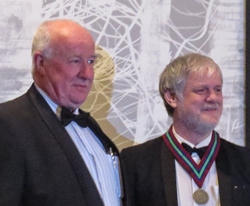
Dr Kellow presented with the FAP Award by john Moore, APF President. APF AGM Sept 2017 Melbourne
Dr Geoffrey Kellow has been a tireless worker for philately wherever he has lived. He has been involved at Club level as an office bearer of several clubs. At State level as Chairman of Philas Library Inc., He has also been part of a team that reintroduced national exhibitions to New South Wales. Geoffrey has also been recognised at both the national level initially with an Australian Philatelic researcher award and later as a Member of Australian Philately, At the International level Dr Kellow is one of the few Australians to have signed the Roll of Distinguished Philatelists.
Since 2006 Dr Kellow has maintained his collecting interests in Australian Colonies particularly Victoria. He has also developed collections of traditional philately and postal history of Sierra Leone.
Although this level of award looks at his efforts since 2006 Dr Kellow has worked for over 35 years, firstly in Victoria with the Royal Philatelic Society of Victoria Inc and since 2003 in New South Wales with the Royal Sydney Philatelic Club through its Australian States Study Circle and with the Australian Commonwealth Collectors Club (ACCC).
Geoffrey has served as a Vice President of Philas (Philatelic Association of NSW) since 2004 through his chairing of the Philas Library Inc.
The Philas Library is housed on one floor of Philas House and contains an extensive collection of books, journals, Price catalogues and Auction catalogues. Dr Kellow has been instrumental in composing electronic catalogues of the Book and auction catalogue collections.
Through the efforts of Geoffrey Kelllow the Philas Library is one of three Australian members of the Global Philatelic Library that is co-ordinated by the Royal Philatelic Society of London and the American Philatelic Society.
Under his editorship the Australian Commonwealth Specialists Catalogue has been extensively updated by the inclusion of data from archival records. In 2013 Brusden-White the producers of the catalogue produced the first detailed listing of Australian Commonwealth postal
stationery in the pre-decimal period.
Geoffrey has maintained his hand in authorship with the publication in 2011 of “Australia: 1927 The Canberra Commemorative. He has also assisted other authors by taking on the task of general editor of their publications.
As editor of the ACCC Bulletin Dr Kellow has overseen the progress of this pre-eminent journal of the philately of the Australian Commonwealth with the introduction of colour covers and most recently the option of an electronic version.
On the trade side Geoffrey has been involved with philatelic research and journalism.
Since moving to Sydney he has become involved with the preparation of philatelic auctions.
More recently he has been part of the team that has launched an on-line philatelic auction.
Before moving to Sydney Dr Kellow was a member of the Expert Committee of the Royal Philatelic Society of Victoria. From this he became the Australian Delegate to the FIP commission for the fight against forgeries. Since the FIP Congress in 2016 he was elected chairman of the commission. Geoffrey maintains his interest in detecting and identifying material deleterious to our hobby.
Dr Geoffrey Kellow is an all-round philatelist, a collector of postage stamps, a postal historian, researcher, an author, an editor, a member of organised philately and has been associated with Philatelic exhibitions as an entrant and a judge
Ross Wood
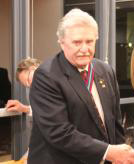 Ross Wood has provided outstanding services to organised philately in an executive capacity. He has served in the following roles:
Ross Wood has provided outstanding services to organised philately in an executive capacity. He has served in the following roles:
36 years at the Philatelic Society of WA (PSWA) in the positions of President, Vice President, Secretary, Treasurer and Committee Member;
23 years on the Western Australian Philatelic Council (WAPC) in the positions of President, Vice President, Public Development Officer and, currently, Secretary;
17 years with the Australian Philatelic Federation (APF) in the positions of President, Vice President, Immediate Past President and Secretary.
Ross is currently the APF’s Aerophilately Commission Delegate – a role he has held for the past 13 years. He is also the current APF Project Officer for the Showman program – a role he has held for the past three years. Ross is the longest serving APF executive.
At the international level, Ross is the current President of the FIP Aerophilately Commission in addition to being a qualified judge for both FIAP and FIP exhibitions in the areas of Postal Stationery and Aerophilately.
From 2009 to 2015, Ross served as the President of FISA (Federation of Aero and Astro Philately) and has been a FISA Board Member since 2009, currently representing Australasia.
Ross is the current editor of several philatelic publications:
30 years with the PSWA’s Stamp Hinges journal;
19 years with the WAPC’s Stamp Groper journal;
and, more recently,
The Australian Aerophilatelist for the Australian Airmail Society.
Ross must know how to squeeze more than 24 hours into each day, because he has also found time to hold more than ten exhibiting / judging workshops at the state and national levels, covering all classes (including classes added by APF in recent years). He has run Aerophilately exhibiting workshops at the national level, such as the one held during the Canberra 2010 show. Also at the international FIP level during Melbourne 2013, PhilaKorea 2014 and Singapore 2015. Ross also championed the successful introduction of the new state-level ‘Subject’ class in recent years.
Commercially, Ross was the Officer-in-Charge of the Philatelic Section for over the counter sales at GPO Perth in 1978-79. He was then promoted to Officer-in-Charge of the Philatelic Bureau for Western Australian stamp collectors for mail orders and distribution to Philatelic sections of Australia Post until 1993 – a total of 13 years of service.
In 1997, his strong contribution to the WA philatelic world was recognised with Ross being awarded the EM Hasluck Medal – the highest philatelic award in WA. He has also been awarded life membership in both the Western Australian Philatelic Council and the Philatelic Society of WA.
As a philatelic exhibitor, Ross has developed fifteen different exhibits since 2003, which have been judged in more than 56 international exhibitions.
To top it off, for those of us who have the pleasure to know him as a personal friend, he is a top bloke. Congratulations Ross; well deserved.
Tony Shields
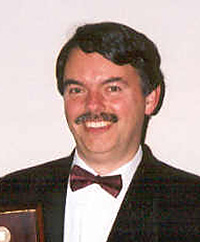 Tony Shields started collecting stamps at the age of five. Nine years later after moving from the country, he joined the Frankston and District Stamp Club as a junior in 1967 and Brighton Philatelic Society in 1968. He was awarded The Ern Allitt Junior Trophy for his B.C.O.F. Japan exhibit at The Victorian Philatelic Association Congress in 1970, and worked for Tam Mappin of Mappin and Curran in their stamp shop over the university holidays. A year later he joined his friend David Kirby and worked at Max Sterns over the next 6 years on a part time and then full time basis.
Tony Shields started collecting stamps at the age of five. Nine years later after moving from the country, he joined the Frankston and District Stamp Club as a junior in 1967 and Brighton Philatelic Society in 1968. He was awarded The Ern Allitt Junior Trophy for his B.C.O.F. Japan exhibit at The Victorian Philatelic Association Congress in 1970, and worked for Tam Mappin of Mappin and Curran in their stamp shop over the university holidays. A year later he joined his friend David Kirby and worked at Max Sterns over the next 6 years on a part time and then full time basis.
Within a year of finishing his Economics Degree and other studies, he married and together with his wife, Christine started a mail order stamp business, advertising in The Australian Stamp Monthly, and selling on exchange sheets. He helped re-establish the defunct Eltham Stamp Club (now Diamond Valley Stamp Club) and was its foundation Vice President, and in due course its President for over 10 years. He continued as a member for over 20 years.
He opened his first shop on 1st March 1979 in Greensborough and joined the Australasian Stamp Dealers Association. Within a year he was asked by Max Stern to join the committee, and by 1982 was President of the Victorian Chapter of ASDA and already on its National Board. At his first meeting as President there were 85 members and Associate Members in attendance, which was a fairly daunting task to chair! The main discussion was about opening hours for the forthcoming world stamp exhibition, Ausipex. He became a delegate to The Victorian Philatelic Council in the same year. Tony was ASDA National Vice President in 1984 for Ausipex and involved on some of the organising committees, including the VPC.
In 1985 Tony attended his first Australian Philatelic Federation meeting as a trade observer, and now some 31 years later, having attended most meetings in the meantime, he still does!. Also that year he became the youngest ever President of the national trade body ASDA – now called The Australasian Philatelic Traders Association. He has held that position a record number of times, and undertook a massive restructuring of that organisation in the 1990s to turn its fortunes around and establish it as the most successful stamp dealers association in the world. Membership boomed and Tony was actively involved in obtaining most of the new ones through his international contacts. He also established a national circuit of APTA stamp shows, organised dealer bourses which were only open to the trade, proposed and helped to organise National stamp Dealer Conventions to educate the trade in various business matters, and helped to run a significant number of social events including golf days and a car rally. Many of his ideas for promoting shows and the trade are still used today. It was his idea to overprint booklets for 1989 Tram Show in Melbourne, and that idea has been used by virtually every show ever held in Australia since then, to help raise funds to run the show. Subsequently he did the same for exhibition covers and Philatelic Numismatic Covers. The idea has been copied by many other trade bodies around the world and even Australia Post and by now has raised hundreds of thousands of dollars for organised philately and the trade.
In 1986 Tony was elected as a trade delegate on The Australia Post Marketing and Advisory Committee – APMAAC, and continued on that body till its effective demise a few years ago. As always, Tony had a significant input to that committee and several of his ideas were adopted by Australia Post, including issuing specialised Year Albums in 1989-1991, which catered for collectors wanting booklets, reprints, self adhesive stamps etc. He also suggested that Australia Post provide First Day Covers to standing order customers on a quarterly basis, at a discount to encourage collectors – which they still do.
In 1989 Tony attended his first overseas stamp show, which was in Singapore. Since then he has been a stand holder at hundreds of overseas stamp exhibitions, in 22 different countries, and significantly helped to promote Australian Philately in the process. He has joined trade bodies and collectors clubs in virtually all of them. In Australia Tony was Vice President of Melbourne Stamp Show 1989 and the last 4 world stamp exhibitions held in Australia – Melbourne 1999, Olymphilex 2000, Pacific Explorer 2005 and Australia 2013. He was a very active contributor to all of these and it was his idea at the Victorian Show in Wodonga to hold Australia 2013. In addition, he has been on many of the organising committees of National and Half National shows run in most states.
Tony and his business have received many trade awards from the national trade body including Dealer of the Year on numerous occasions. In 2002 he was the first non British person to be awarded The Roland Hill Philatelic Award in London for “Enterprise and Personal Contribution” to the trade and hobby. The award was given by the British Post Office and Philatelic Traders Society Later in the same year he became the first ever recipient of the SPAN award from APF, and in 2007 was awarded life membership of APTA -one of only 7 people to be ever awarded this honour.
He has published many articles over the years in Australian and international philatelic magazines and newspapers, and for 25 years was a regular member of the Antiques and Collectibles Show on radio 3AW in Melbourne, which had tens of thousands of listeners over that time, and was consistently the highest rating radio show overnight.
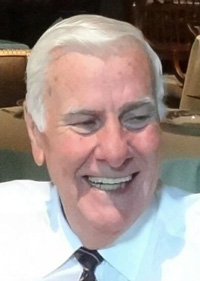
Arthur Gray has been a prolific and successful exhibitor in his field of Australian Commonwealth since 1998. He has achieved LG standard exhibits in all aspects of early Commonwealth philately with a Grand Prix, in Hong Kong in 2009 FIAP Exhibition. He undoubtedly is the most successful Australian exhibitor of current times.
He has been a stalwart and Life Member of his home club, the Australian Commonwealth Collectors Club and is Fellow of the RPSL, being the only member to show at 2 consecutive meetings. He is a Fellow of the RPSV, showing on regular occasions over the past 10 years. He has also presented at the Collectors Club of New York. He was a generous speaker at Clubs and Societies and every state has been the beneficiary of his displays and knowledge, over many years. He willing made available his knowledge for the production and revision of the Australian Commonwealth Specialists Catalogues and to other researchers.
He was a significant member of the Committee of the International Exhibition “Australia 2013” held in Melbourne. His efforts in his role as Sponsorship Vice-President resulted in significant sponsorships being secured, which ensured the exhibition had a successful outcome. His negotiating skills resulted in the largest sponsorships undertaken by several supporting companies.
He is a tireless promoter of Australian Philately when overseas and a strong advocate for philately in his part of the world.
In
Malcolm Groom
Malcolm Groom has made significant contributions to philately, the APF and the Tasmanian Philatelic Society over many years. In 2003 he was awarded the Member of Australian Philately. At that time he had been a stalwart of the APF executive since 1986 including periods as President, Development Officer, Treasurer and various project duties. He was also a driving force in the Tasmanian philatelic Society and a Life Member. He performed distinguished service on FIP bodies.
including periods as President, Development Officer, Treasurer and various project duties. He was also a driving force in the Tasmanian philatelic Society and a Life Member. He performed distinguished service on FIP bodies.
Malcolm had formed at least 6 Exhibits achieving up to LV internationally and his research had been published in The Courier, Philately from Australia and Postcript.
He had served on the Australia Post Stamp Advisory Council and was the President of the Tasmanian Stamp Council.
He was an experienced International Judge, Member of the FIP Postal History Commission, presenter of the APF’s Executive Development Program as well as a trainer of Australian Commissioners and Judges.
Since the award of MAP 10 years ago, Malcolm has continued and expanded his high level of involvement with the APF, TPS and State and National Stamp Councils as well as the promotion of Philately, teaching and research.
Some of his more notable achievements over the last 10 years since 2003 include:
- Judging at Australian and international exhibitions and has gone on to serve as assistant exhibition secretary and exhibition jury secretary at international level.
- Secretary-General of the FIAP and has been an Executive member from 1999.
- A member of the FIP Postal History Bureau from 1998 to 2008 and is now an invited member.
- Award of national Gold and international Large Vermeil medals for Postal Stationary Exhibit, international Large Vermeil for Postal History Australian External Airmails, international Large Vermeil and National Large Gold for Traditional Tasmanian Pictorials.
- Regular publication of results of philatelic research in The Courier
- Development of a phone App for Australia 2013
- Editorial Committee of The Courier since 2009
- Presentation of seminars at a number of international exhibitions
- Presenting training courses for national Commissioners and Judges
- Prominent speaker to the press for Australia 2013 and on Tasmanian Talk back radio
Malcolm’s most recent achievement and on of the most significant has been to Chair the organising Committee for the very successful Australia 2013 International Exhibition.
Maurice Williams AM
Maurice Williams has made a significant contribution to philately at the national level through his position as Chairman of Australia Post, and through his support for organised philately both
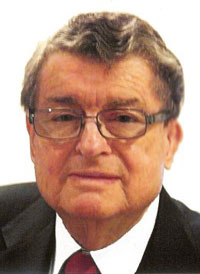 as an executive member of philatelic societies and as an exhibitor in National and International Exhibitions.
as an executive member of philatelic societies and as an exhibitor in National and International Exhibitions.
During his Chairmanship of Australia Post he oversaw a number of initiatives in the fields of postal technology and stamp production that impacted on our hobby at the national level. His association with firstly Australia 99 and Pacific Explorer 05 enhanced his interest with philatelic exhibitions.
Maurice’s association with exhibitions started at an administrative level. It has progressed into the enjoyment of preparing exhibits for National Exhibitions in the Social, Open, Traditional and One Frame Classes. He has combined an interest in local history and philately in developing his Social Philately exhibit on the Sydney Harbour Bridge. Maurice has also developed entries on QANTAS and the stamp engraver and designer Frank Manley. His longstanding commitment to organised philately continues. He is a member of the Sydney Stamp Expo 2011 Organising Committee and also has entered a Traditional Class exhibit.
Through his work and then through his hobby Maurice Williams has brought Australia Post and organised philately closer together at the national
level. It is fitting that these major contributions be recognised by the APO.
David Ingle (Dingle) Smith, FAP
David, more commonly known as Dingle, Smith has been a driving force in promoting philately in the Australian Capital Territory for many years. He has been a member of the Philatelic Society of Canberra 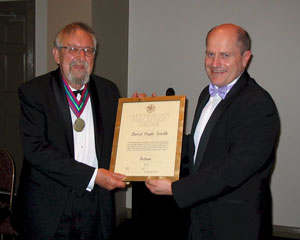 for about 30 years and a member of the Australian Capital Territory Philatelic Council since its inception in 1980. He has held a number of positions in both organisations including terms as President. He was made a Member of the Australian Philatelic Order in 1996. Since that time, Dingle has continued to work actively for the benefit of Philately at local, state, National and International levels. His contributions since 1996 have included:
for about 30 years and a member of the Australian Capital Territory Philatelic Council since its inception in 1980. He has held a number of positions in both organisations including terms as President. He was made a Member of the Australian Philatelic Order in 1996. Since that time, Dingle has continued to work actively for the benefit of Philately at local, state, National and International levels. His contributions since 1996 have included:
Becoming a Member of the Bureau of the FIP Commission for Revenue Philately including becoming Secretary of the Commission in 2008
Being awarded the Shakespeare Prize for services to Philately in the ACT in 2004
Becoming a FIP Postal Stationery judge in 2001, cross accrediting in Revenues in 2008
Has been the Convenor of NAPE from the early 1990s until the present
Continued his involvement as a member of the Council of the Philatelic Society of Canberra (until 2002) and the ACT Philatelic Council (until the present including being Secretary of the Council from 2000-2007)
Was a member of the ACT sub-committee for Olymphilex 2000, (an international philatelic exhibition), with an active role in the organisation of the Olymphilex Canberra ‘annex’ at the Royal Australian Mint
Has been a member of the organising committee for the National Exhibition Natstamp 98 and for the modified National Exhibitions held in Canberra from 2000-2008 including roles as Jury Chair, Exhibitor Liaison and Dealer Liaison.
Continued to obtain higher awards for his exhibits with his Postal Stationery of Jamaica receiving a Gold medal at Washington 2006 as well as exhibiting in new collecting classes and challenges including exhibiting in the first FDC class in 1998 and becoming the first qualified Australian FDC judge.
Continued to publish research articles and monographs including (with R Peck) the Priced Catalogue of New South Wales Revenue & Railway Stamps (1999) published by the Cinderalla Stamp Club of Australasia, and the standard monograph on the subject.
Continued to upgrade his judging skills being Jury Chair in at least four modified or half National Exhibitions
Continued to actively participate in the training of ACT state judges through being a presenter at State Judging Courses and in some cases being the organiser of these events.
Appointed as a National Commissioner to China 2009 and as an Accord Judge to Canada in 1999
Dingle was an inaugural member of the ACT Youth Philately Clubs Organising Committee and acted as ACT Philatelic Council youth coordinator for several years. He organised and ran courses on stamp collecting for the ACT Stamp Promotion Council and the Philatelic Society of Canberra, been a teacher at advanced collector and exhibitor courses run by these organisations and been a member of the training panel for State level judges courses since 1984. He has also provided radio publicity for philately in the ACT region for both the ABC and commercial stations.
Dingle was presented with his Fellow of the Australian Philatelic Order Medal by Noel Leahy of Australian Post, at the 2009 APO Awards Dinner held at the Hellenic Club in Canberra on Saturday, 29 August.
Bernard (Bernie) Doherty
Bernard (Bernie) Doherty exemplifies the “all round” approach of Australian Philately. He has worked at Club, State, National, Regional and International levels. In organised philately he has been an “all rounder” at Club and 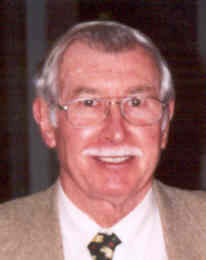 State level, whilst working at the National level over a 13 year period, initially in Collector Youth Liaison, Publicity and subsequently in administration as President.
State level, whilst working at the National level over a 13 year period, initially in Collector Youth Liaison, Publicity and subsequently in administration as President.
Bernie is one of a few people in organised philately that is based outside the capital cities. He has had a relationship of over 29 years with the Newcastle Philatelic Society where he served in a range of positions including 22 years as Secretary (1980-2002). Bernie was instrumental in organising Philatelic exhibitions in Newcastle in 1987, 1991, 1994, 1997 & 2003. He also wrote a History of the society’s first 75 years.
Bernie joined the NSW Stamp Council in 1990. He was Vice President from 1990-1992 and Secretary from 1992-1995 and then as a committee member 1996 to the present. He was able to steer the Council over a number of years.
Bernie’s contributions to the Australian Philatelic Federation are many and varied. In 1990 he re-established a presence from NSW after a break of many years. In later years he was able to get other NSW philatelists to serve on the Federation. His emphasis on the Federation started in Adult and Youth Development. Later he used his skills in journalism as Public Relations Officer and editor of APF News. Less well known but just as important was his work in recording the policies of the APF into an accessible and user-friendly form.
Bernie also worked in an administrative capacity for two Sydney based Exhibitions. As president of Sydney Centrepoint 95 he brought a National Philatelic Exhibition to Sydney after a long break. He was also Commissioner General to Olymphilex 2000, a job that gave him experience at the international level.
Bernie has served as a judge and/ or state commissioner at most Australian Exhibitions since 1992. These jobs are both physically and intellectually demanding. He is always prepared to assist with such tasks as Frame assembly and mounting exhibits.
Bernie’s collecting interests are wide. His Social Philately of Newcastle is renowned. He has also written a postal history of Newcastle Post Office and developed a postal history exhibit on that topic. In Traditional philately Bernie has concentrated on Postage Dues an area which others have shied away from. He formed two major Postage Due collections, the first on the Australian Commonwealth and the second on South Africa. Bernie’s interest in Southern Africa also took him into the field of the Postal Cards of South Africa which from the early 1940’s depicted a range of scenes. Bernie also participated in each of the Challenge’s organised by the APF.
For 10 years (1990-2000) he was editor of Stamp News. This publication at the time was a good example of regional diversity. Its Philatelic editor was based in Newcastle and the General Editor was in Dubbo and the production plant was first in Dubbo and later in Sydney. During that time was also editor of APF News.
Bernie has always been ready to assist others in developing their interests in our hobby. He has been associated with educational groups such as WEA (Workers Educational Association) and U3A (University of the Third Age). At exhibitions he is always willing to speak to other exhibitors on how things may be improved.
Bernie’s interest in computers took him to working with Hans Karman on the Showman Program which demonstrates how technology may assist exhibition organisers and be an aid to jury recording.
Bernie has shown that philately is throughout Australia and not just Capital city based. He has taken our hobby to other areas with the hope that it would prosper. Writing and other means of publicity has been one of his main tools. He has consistently worked with exhibitions. Above all he has served Philately at a range of levels.
Ross Duberal
Ross Duberal is best known for his traditional exhibit of Fiji, but he also has exhibits of Fiji postal stationery,  Aitutaki, Honduras and Western Australian postal history. He has shown these exhibits widely at State, National and world exhibitions in the period 1967 to 1994, achieving many awards.
Aitutaki, Honduras and Western Australian postal history. He has shown these exhibits widely at State, National and world exhibitions in the period 1967 to 1994, achieving many awards.
Ross has served as an Executive member on most Western Australian State level exhibitions since 1979 and on several occasions been either Jury Chairman or Committee Chairperson. He has judged at State and National Exhibitions as well as the World exhibitions at Ausipex ’84 and Grenada ’92.
Ross was co-author of Fiji: the stamps and postal history, 1870-1875 published in 1970. He also wrote two chapters and prepared all the illustrations for Western Australia – the stamps and postal history published by the Western Australia Study Group in 1979. Additionally he has written many articles for world-wide journals and was editor of Black Swan from 1975 to 1980.
Ross is a member of the Philatelic Society of Western Australia and in 1974 was co-founder of the Western Australia Study Group, on which he has served in various Executive positions. He has also been President of the Western Australia Stamp Promotion Council and the Western Australian Philatelic Association and is currently a Committee member of the State Philatelic Council.
With the formation of the National Association of Philatelic Exhibitors, Ross w as elected Secretary / Treasurer in 1991/92 and editor of the Association journal form 1988 to 1992.
Ross has been extensively involved in the fields of education and training at both junior and adult levels. He has also undertaken several radio and TV interviews to promote the hobby and been guest writer for a short period on “Weekend News”.
In 1987 he was awarded the Hasluck Medal for outstanding service to Western Australian philately.
[ Source: APF News July 1995 ]
2004 Citation – Fellow
Few Australians can have contributed so much to the hobby as Ross Duberal. He has been involved in the hobby in a serious way for some 40 years as exhibitor, judge, commissioner, administrator, and author. In addition he has been at the forefront of all the developments that have occurred in Australian Philately in the last quarter of a century and which have placed Australia in the current high position it enjoys in world opinion.
From the time when he was appointed a Member in 1995 he has continued his extensive commitment to Philately at every level. He has continued to exhibit not only his Traditional collection of Fiji and for which his awards continue to improve but extended to it to Postal Stationery whilst also adding collections of Honduras and a Thematic Volcano collection to his exhibits. He has built a large collection of Western Australian Postal History for which his research on the subject is extensive.
He has continued to judge at WA State exhibitions as Chairman of the Jury, National, as well as on International juries where he has added Literature to his accepted classes.
He has continued to serve as a Commissioner at both National and International exhibitions.
However it is in the field of philatelic publication that we see Ross’ s greater achievements with recently a comprehensive book on the Postal Stationary of Fiji as well as an extensively researched monograph on the 5 shilling Queen Victoria issue of that country. Both of these publications are regarded as the last word on the subjects and have been internationally acclaimed. He contributes articles and commentaries as well as being an active member of several specialist societies -not least those dealing with judging such as the Australasian Exhibitor (of which he was the founder editor) but also the American Philatelic Exhibitor.
Ross has also worked tirelessly in his home state as a judge, mentor and administrator. He is always part of any workshop or seminar which occur regularly in WA both at Clubs as well as at those initiated by W APC. In addition Ross founded and continues to run the Daytime Stamp Club after some six years which is a potential model for others to follow given the increasing popularity that it has achieved since it began.
Few collectors could have put in the time and devotion to philately that Ross has given to help other collectors including youth and the disabled. He is ever present at meetings when issues need consideration -sometimes with controversial ideas but always constructive with the good of philately at heart.
[ Source: APF News, August 2004 ]
Bernard Beston
Bernard Beston of Brisbane, who has been a stamp collector since his youth became involved in organized philately in the 1960s. Since that time he has keenly supported and tirelessly  promoted the hobby at all levels.
promoted the hobby at all levels.
Bernie has been a member of the PS of Queensland for some 40 years, serving as President on 4 occasions. He has been a member of the Queensland Philatelic Council continuously since its inception in 1985 serving in various executive offices.
Bernie served with distinction on the APF for 13 years between 1984 and 1999 as variously Secretary, International Officer, Vice President and President. He was heavily involved in the organization of five National Exhibitions staged in Queensland and was President of the Organizing Committee of Olymphilex 2000 in Sydney.
Bernie served as Vice President of FIAP for 10 years [1985-95] and involved himself in training and teaching seminars in all but 4 Asian countries during the past 15 years.
He has been a prolific exhibitor since 1979 with a broad range of exhibits covering Postal History, Thematics, Postal Stationery, Aerophilately and Maximaphily. Most notable awards at FIP World Exhibitions from an extensive lists are FIP Gold Medals for Queensland Postal History 1841-1891 [London 2000], Postal Stationery of Queensland [Belgica 01] and Postal Stationery of British Guiana [España 2000].
As an accredited national judge since 1982, Bernie has served on at least 20 national juries, several times as Chairman. After serving his international jury apprenticeship in 1984, he has served on 5 FIP and 10 FIAP juries, being jury chairman at Hong Kong 87, Jakarta 95, Hong Kong 97 and Australia 99.
In the past two decades Bernie has penned innumerable philatelic articles which have been published in a wide range of philatelic journals and catalogues.
Bernie has undertaken duties as State Commissioner, and six times as a national commissioner. A long-serving member of the AP Production Marketing and Advisory Committee from 1985 to 1998, the FIP Commission delegate for Maximaphily 1990-2002, and since last year for Postal Stationery. Bernie has also acted as a philatelic consultant to the postal administrations of Norfolk Island, Fiji, Nauru, Samoa, Solomon Islands and Vietnam for many years.
In short, a dedicated philatelist who has given exemplary service to Australian philately over several decades and a most deserving recipient of the highest award Australian philately can bestow on him.
[ Source: APF News, July 2003 ]
Max Stern, FAP (Hon)
In 1946, Max Stern became the First post-WWII overseas member of the American Stamp Dealers’ Association and, since that year has also been a member of the International Federation of Stamp Dealers 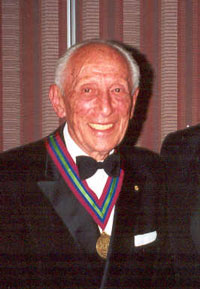 Association, as well as its President for a period.
Association, as well as its President for a period.
He had arrived in Australia from Czechoslavakia in 1948, and created a niche business in Australia by wholesaling world new issues to the trade. In 1950 he opened his first stamp shop in Melbourne in the Empire Arcade. He has enjoyed a distinguished career in the stamp industry both as a trader and a member of organised philately.
He was admitted to membership of the then ASDA, in February 1950. It is a measure of his enthusiasm and ability that within six months of his joining the ASDA, he became its Secretary. He also served as President of the Australian Stamp Dealers’ Association in 1954, 1955 and 1956; and continued as a committee member for over 40 years. He is an Honorary Life Member, as well as the longest serving Australasian Stamp Dealers Association/APTA member who is still active in stamp trading. His firm is arguably the largest retail philatelic operation in Australia, now representing thirty or more major overseas Postal Administrations, and services the trade and collectors worldwide.
Max has always been dedicated to his industry and has introduced new concepts in stamp promotion and advertising. He developed a giveaway scheme which operated between 1963 and 1965, expanding the number of stamps available to collectors. This laid the basis for a strong growth of Australian philately in the 1960s and 1970s.
He received the Victorian Philatelic Association Award of Merit in 1970. Max Stern helped found the Victorian Philatelic Council, and served as its President and Secretary for several years. He also served as a member of the Australian Stamp Promotion Council, which later became the Australian Philatelic Federation. During 1974 when he was a member of the Victorian Stamp Promotion Council, he also assisted in the initiation of the first National Stamp Day in 1974, which has since developed into National Stamp Collecting Month, an annual philatelic promotion by Australia Post. 1979 saw him become the first Australian registered stamp valuer for taxation purposes [Department of Home Affairs]. He drafted the original submission to Australia Post to finance AUSIPEX 84 in 1982. He was Trade Adviser to AUSIPEX ’84: Australia’s first World Philatelic Exhibition and served as a member of the Organising Committee.
Using his years of experience and international contacts, he helped organise Australia’s first joint stamp issue with the United States of America and Britain, to celebrate the bicentenary in 1988. He also assisted with negotiations for a joint issue with the USSR. He has over the years acted as a specialist adviser on international marketing to Australia Post and represented them at overseas stamp exhibitions. Another of his trade appointments was as official agent for the Royal Australian Mint and Note Printing. He assisted fundraising for the Royal Women’s Hospital by donating prizes and complimentary stamp packs.
This prominent Melbourne stamp trader was honoured in June 1999 when he was appointed a Member of the Order of Australia in the Queen’s Birthday Honours list. He received his honour for services to stamp collecting and for his promotion of Australian stamps overseas. His nomination received worldwide support from members of the stamp trade, Postal Administrations as well as collectors.
There can be no question that Max Stern has made an outstanding contribution to the stamp trade and philately in Australia. He is indeed a worthy Honorary Fellow of the Australian Philatelic Order. The presentation was made by ACT Chief Minister the Hon. Mr Gary Humphries, MLA.
[ Source: APF News, October 2001 ]
David Maiden, Honorary Fellow
On 5 August, 2000, the bestowing of an Honorary Fellowship took place in Melbourne for the first time. That 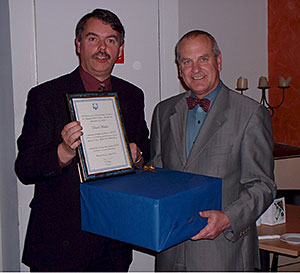 honour was awarded to David Maiden, then Group Manager (Philatelic) of Australia Post.
honour was awarded to David Maiden, then Group Manager (Philatelic) of Australia Post.
David Maiden had been the Australia Post Philatelic Group Manager since November 1991. One of his tasks on joining the Philatelic Group was to preside over the opening of the National Philatelic Centre, located on the ground floor of Australia Post House in Melbourne. The Centre provides a showcase for treasures from the national archival collection, including stamp artwork, proofs and printed sheets, the Chapman Collection, and the stamp dies produced by Note Printing Australia.
David revived the concept of Stamp Collecting Month as a major annual promotion of stamp collecting by Australia Post, focusing particularly on young people. The theme of the first of the new-look, Stamp Collecting Month stamp designs was dinosaurs.
At a time of considerable change within Australia Post, with an entirely new approach to retailing, David Maiden has provided the human face of this vast enterprise as far as collectors are concerned. His column in the Australian Stamp Bulletin attracts a large volume of correspondence, all of which is personally answered.
David has made it his business to connect with all facets of philately – from the hard-nosed world of stamp traders, to the smallest of local stamp clubs, to the cream of elite collectors. He attends meetings of them all, gives informal presentations, and patiently answers questions from the floor.
His most memorable contribution to Australian philately has been the leading role he played in Australia 99: in persuading Australia Post to finance the exhibition; as the Expo’s Vice President, as a driving force on the Organising Committee; and in mobilising his staff to make the exhibition such an outstanding success. He also presided over the introduction of Personalised Stamps at the Expo, an innovation which may assist in prolonging the life of the postage stamp in this country.
Above all things, he is a communicator, and he has succeeded in building a bridge between the tall building in which he works and the wide world of philately, which has enabled a two-way flow of communication on a continuous, informed and friendly basis. David Maiden is a very worthy person to be selected as the first Honorary Fellow of the Australian Philatelic Order. The presentation was made by Maurice Williams, Guest of Honour.
[ Source: APF News, October 2000 ]
Postscript
On the 20th September 2002, David Maiden retired as Australia Post Philatelic Group Manager, a post he has held since November 1991. David had made it his business to connect with facets of philately – from the world of stamp dealers, the many stamp clubs, large and small to the cream of elite collectors.
In exhibitions in Australia, David has been at the forefront with his role as a Vice-President at Australia 99; to his financial support and in kind assistance to the National Exhibitions that are held yearly. As one of the last involvements with Australian Philately, David was part of the steering committee for the modified FIP World Exhibition held in Sydney in April 2005, Pacific Explorer 2005.
On August 5th 2000, David was honoured by the APF with the bestowing of an Honorary Fellowship of the Australian Philatelic Order. The APF wished to recognise the work done by David for Australian Philately.
• David revived the concept of Stamp Collecting Month as a major annual promotion of stamp collecting by Australia Post, with a focus on young collectors.
• With Australia Post’s approach to retailing changing over the past decade, David provided the human face of this vast enterprise for the collector.
• David’s support for the APF is well known and he enjoys a close relationship with the members of the Federation’s executive.
This previous month for David has been a busy one:
• He gave an excellent talk at the Philatelic Gallery in Melbourne on the past, present and future of Australia Post involvement in Philately.
• The Australian Philatelic Traders’ Association, the third leg of the philatelic stool, honoured David with a valedictory dinner.
• He attended the 2002 APF AGM in Adelaide and being no different to any other time in the job was ready and willing to answer questions.
• Together with his wife, Trudi, he attended the APO Awards Presentation Dinner on 31st August 2002 in Adelaide.
Thanks David and best wishes to your future where ever it may take you.
[ Source: APF News, November 2002 ]
Raymond Kelly
Raymond John Kelly, who was born in 1927, was encouraged by his grandmother during the mid-late 1930’s to explore the world of stamp collecting. Ray was educated at the South Melbourne and  Footscray Technical Schools, before being employed as an Engineering/Planning Draftsman with Olympic Tyre Co, later as Chief Draftsman with the Australasian Petroleum Co in Port Morseby. A resident of Papua from 1949 to 1958, Ray joined the Papuan Philatelic Society in its foundation year – 1954 – his first introduction to organised philately. He became that society’s Secretary in 1958 (until 1958) and was its president between 1966 and 1970. Ray was editor of PPS Stamp News from 1955 to 1957 and again from 1963 to 1971. He is an author of numerous articles on PNG philately and received that society’s Award of Merit in 1976 for services to society.
Footscray Technical Schools, before being employed as an Engineering/Planning Draftsman with Olympic Tyre Co, later as Chief Draftsman with the Australasian Petroleum Co in Port Morseby. A resident of Papua from 1949 to 1958, Ray joined the Papuan Philatelic Society in its foundation year – 1954 – his first introduction to organised philately. He became that society’s Secretary in 1958 (until 1958) and was its president between 1966 and 1970. Ray was editor of PPS Stamp News from 1955 to 1957 and again from 1963 to 1971. He is an author of numerous articles on PNG philately and received that society’s Award of Merit in 1976 for services to society.
Ray has formed and continues to form key collections in several areas including traditional Papua (gold medal and special prize at Adelaide 1972), Port Phillip District Postal History (gold medal and special prize at New Zealand 1986), Papua-New Guinea Airmails (gold medal and special prize at Chicago 1992), Advertising by Post (social philately) (gold medal and special prize at Western Australia 1994), Havelock-Fosters (one frame) (diamond and special prize at New Zealand 1996) and Denmark Postcards (postal stationery) (gold medal and special prize at Fremantle Stampshow 1997).
Since that time, Ray Kelly has worked tirelessly for philately. He was dedicated 44 years of service to the hobby which covers a broad spectrum of philately; administration of clubs, State and National level teaching, training, philatelic study and research while forming several distinguished philatelic collections, together with judging and exhibiting.
In Australia, Ray was a member of the Ballarat Philatelic Society, serving on its committee from 1960 to 1970. He held the position of President from 1961 to 1963 and was one of the chief planners and organisers of the 1965 Victorian Philatelic Council Congress in 1965 and the 1972 Jubilee Exhibition. He was the society’s delegate to the Victorian Philatelic Association from 1961 to 1966 and the Youth Club convenor in 1963 and 1964. Ray also arranged and presented a thirty minute monthly program for Youth Philately on BTV6 during 1964 and 1965.
Ray Kelly has also been a member of the Royal Philatelic Society of Victoria since 1966 and has held a number of important roles over the last thirty two years including VPC delegate from 1984 to 1987, Curator of the Forgery Collection from 1978 to 1986, and has been a member of the Publications Committee since 1987.
Ray Kelly has previously been a member of the Australasian Stamp Dealers Association between 1970 and 1994 and a Committee member of that organisation during the period 1971-1987. He was Treasurer from 1971 to 1975 and later President between 1977 and 1979.
Ray’s many other services to philately include member of the Australian Philatelic Federation from 1986 to 1991 (as an ASDA delegate), and then from 1992 to 1997 as an Executive Committee member. He was President of the APF between 1993 and 1995.
Ray has also been an integral part of major exhibitions within Australia and overseas. He was President of Stampshow Melbourne 1991 and Melbourne 96, both national exhibitions as well as Vice President of Stampshow 94. He was editor of the catalogue and responsible for the layout and design of the Stampshow Melbourne 89. He was involved in various sub-committees of Ausipex 1984 and is currently an Organising Committee member of Australia 99. Much of Ray’s contributions to the design and development of philatelic products may not be known to many, but Ray has been behind number items such as the 1965 VPA Congress envelope, the 1991 Melbourne national exhibition envelope, the 1993 VPC Medallion and Award of Merit Certificate, the 1994 Melbourne exhibition envelopes and medallion, the 1995 APF Philatelic Order Award certificates, the 1995 APF 2-piece National Exhibition medals (currently in use), the 1996 Melbourne exhibition souvenir envelope and the 1997 APF Research Medallion and Certificate (original concepts).
Ray has judged at a total of 17 national philatelic exhibitions in Australia and on six occasions internationally including Melbourne (1984), Bangkok (1989), Kuala Lumpur (1992), Singapore (1995), Honk Kong (1997) and Adelaide – FIAP (1986). He has been national jury chairman on three occasions – in Melbourne in 1989, 1994 and 1996 and been a state commissioner to national exhibitions in Brisbane in 1982 and 1985.
Ray has lectured in aerophilately at Sunpex 85, Canberra 84 judging course and at the Council of Adult Education in Melbourne with a Philately for Beginners course in 1982 and 1983. Ray conducted the Victorian philatelic judges course in 1991, and lectured in the Royal Philatelic Society of Victoria’s School of Philately on aerophilately and judging in 1986and again in 1996. He conducted the first Judge’s Critique session at a national exhibition in Canberra in 1984 and lectured at the APF national commissioners’ course in Sydney in 1995. Ray has also published many articles on a wide range on philatelic subjects.
Edric Druce, FAP
Dr Edric Druce has been a keen stamp collector since 1947 and a philatelist since he was in his thirties, having 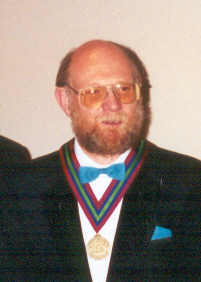 served the philatelic community for the past twenty years. He is best known as a Postal Historian and has put together several major collections and exhibits. Best known is his ‘New South Wales’ which has been awarded Large Gold medals at world exhibitions and won the ‘Champion of Champions’ Class for the decade 1985-1994 at Canberra in 1996. This exhibit was displayed in the Court of Honour at both Sydpex 88 and Taipei 93.
served the philatelic community for the past twenty years. He is best known as a Postal Historian and has put together several major collections and exhibits. Best known is his ‘New South Wales’ which has been awarded Large Gold medals at world exhibitions and won the ‘Champion of Champions’ Class for the decade 1985-1994 at Canberra in 1996. This exhibit was displayed in the Court of Honour at both Sydpex 88 and Taipei 93.
He is also a keen postal stationery collector and has put together world class exhibits in that class as well as Thematics and Aerophilately. He has won Australian Grand Prix for Postal History, Postal Stationery and Aerophilately and best in class for Thematics, One Frame exhibits and Frugal Philately. A wide range of collecting interests typifies Ed’s approach to the hobby. Many of these collections have been turned into high award winning exhibits such as New South Wales Postal Stationery (Gold), British Colonies Aerophilately (Large Vermeil), The Story of the Earth (Large Silver), Canberra Monaro Region (Social Philately) and Tonga (Frugal Philately). Dr Druce has displayed various collections extensively including to the Philatelic Society of Canberra, Philatelic Society of Queensland, Philatelic Society of New South Wales, Royal Philatelic Society of Victoria, Tasmanian Society, Philatelic Society of South Australia, and the Western Australia Study Group. He has also displayed to the Toronto Philatelic Society, and the Philatelic Specialists Society of Toronto and the Postal History Society of the UK.
Dr Druce has spent much of his time in supporting and developing organised philately in the Canberra region, at the national level and internationally. He is a long standing member, and former President of the Philatelic Society of Canberra as well as a member and former President of the ACT Philatelic Council. He is a past (and inaugural) president of the Australian Philatelic Federation and former International Officer of that organisation. He is a national and international judge (Postal History and Youth) and also is a Bureau member of the Postal History Commission.
He has run training courses in philately and particularly postal history in the ACT and other Australian states and territories as well as in China, Indonesia, New Zealand, Canada and Taiwan. He introduced Judges training programs in the ACT and at National level and introduced a Commissioners’ training program for national commissioners. In the ACT he has assisted in running Schools of Philately, exhibiting courses and judges courses. He was guest speaker at the Australian Stamp Dealers Association inaugural international convention. Dr Druce was in inaugural member of the Australian Philatelic Judges register and is a qualified team leader in Postal History, Postal Stationery, Thematics, Social Philately, Revenues, Literature and Youth Philately. He was Chairman of the Jury at Sunpex 85, AUSTAMP 90, Melbourne 91, Canberra 94 and several state shows in the 1980’s and 1990’s. He has also judged at New Zealand exhibitions and the Canadian Nationals Royal Hamilton 90 and Calgary 97. Dr Druce is a qualified FIP Judge in Postal History, Postal Stationery and Youth Philately. He has judged at the following FIAP shows: Adelaide 1986, Surabaya 1994, Taipa 96 and Hong Kong 97 and FIP exhibitions: Praga 88, Brasiliana 94, Capex 96 and Indonesia 96 and Indepex 97.
Few people can claim that they were responsible for the establishment of new exhibiting classes. Dr Druce founded two new classes of competitive philately, Social and Frugal, both of which were first trialled at Canberra exhibitions. Social Philately is an experimental class at Australia 99.
He is also a prolific philatelic author publishing articles on Postal History, Thematics, Aerophilately, Postal Stationery, exhibiting, judging and the trends in philately. He is the past editor of Capital Philately and is currently editor of The Asia Pacific Exhibitor, a journal which has contributed enormously to the health of exhibiting in Australia. Dr Druce has contributed regularly to radio programs of the Australian Broadcasting Commission on philately and wrote a philatelic column for The Canberra Times.
Derek Pocock, FAP
Derek Pocock is recognised throughout Australia and internationally as a philatelist having a wide range of collecting interests including Traditional, Postal Stationery, Postal History, Aerophilately and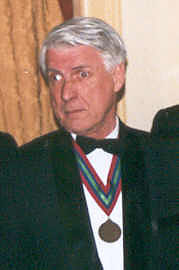 Social. He has had much exhibiting success which is supported by a high level of knowledge. Along with his personal exhibiting knowledge he has developed judging skills and ability, an ability to express his knowledge and has excellent administrative skills.
Social. He has had much exhibiting success which is supported by a high level of knowledge. Along with his personal exhibiting knowledge he has developed judging skills and ability, an ability to express his knowledge and has excellent administrative skills.
Derek, nominated by the West Australian Philatelic Council, was a member of the South Perth Stamp Collector’s Association in 1973, and has served organised philately on State and National executive committees, exhibition organising committees, juries and promotions since that time. He was elected to the committee of the Australian Philatelic Federation in 1986, as Education Officer, and in 1989, President. In 1993, he completed his very capable administrative contribution to the Australian Philatelic Federation as Past President. A number of new ideas were suggested by Derek and implemented, including the exhibition of picture postcards and the concept of half‑national exhibitions.
Derek has widely exhibited his collections of British North Borneo, Nicaragua, “Railway Parcel stamps of West Australia”, “Postal History and Markings of Nepal” and “Western Australia Official Perfins”. The collections have received excellent awards at both national and international exhibitions. Ranging from silver to large vermeil internationally.
Derek has judged at many national exhibitions since 1980, and has served as Chairman of the Jury at four exhibitions. Internationally he is qualified to judge in the Postal History and Literature classes and has judged at four exhibitions.
Derek promotes philately very enthusiastically and has planned and lead courses. Seminars and workshops since 1978. His skills have been sought after and given generously at national philatelic judge training schools. He has developed a very large philatelic library.
Internationally he is the Australian representative on the FIP, Forgeries and Undesirable Issues Commission, a position he has held since 1988.
Derek has written numerous philatelic articles for publication in various journals including Sarawak Specialist (23 articles) and The Black Swan” (20 articles).
[ Source: APF News, October 1997 ]
Raymond Todd, FAP
Ray Todd has a wide range of Postal Stationery and Postal History collecting interests, which have 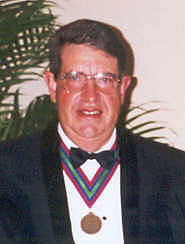 been recognised throughout Australia and internationally as exhibits and for his high level of knowledge in these fields. Together with his personal exhibiting knowledge, he has highly developed judging skills, an ability to express his knowledge and excellent administrative skills.
been recognised throughout Australia and internationally as exhibits and for his high level of knowledge in these fields. Together with his personal exhibiting knowledge, he has highly developed judging skills, an ability to express his knowledge and excellent administrative skills.
Ray, a resident of Western Australia, was nominated by that State’s Philatelic Council. He was made a Life Member of the Philatelic Society of Western Australia in 1969, and has served in various positions on State and National executives, exhibition organising committees, juries and promotions since that time. He began as the Western Australian delegate to the Australian Stamp Promotion Council [later to become the Australian Philatelic Federation] in 1975, and was elected to the Australian Philatelic Federation executive in 1984, as Public Relations officer. In 1992-93, he served as Australian Philatelic Federation President and in 1995, completed his very capable administrative contribution to the Federation Executive as Past President.
Internationally he is a member of the FIP, Postal Stationery Commission and is currently Vice-President of the Federation of Inter-Asian Philately, and editor of the FIAP NEWS.
His postal stationery and postal history collections have received awards at both national and international exhibitions, including a FIP gold medal at Norwex 97 for “Indian Airmails”. He has also served as a team leader on FIP exhibition juries and as the Chairman of the jury at numerous Australian national philatelic exhibitions.
Ray is an enthusiastic speaker and promoter of philately, his skills have been sought after and given generously at national judge training schools and seminars, held in conjunction with both national and international exhibitions, most recently Dubai and San Francisco.
( Source: APF News, October 1997 )
Raymond Chapman, FRPS,L FAP
Ray Chapman’s Australian Commonwealth collection is recognised internationally as the most  comprehensive collection of Australian stamps ever formed. It has been awarded several gold medals at international exhibitions and was the first Australian exhibit to be awarded a gold medal at an FIP World Exhibition.
comprehensive collection of Australian stamps ever formed. It has been awarded several gold medals at international exhibitions and was the first Australian exhibit to be awarded a gold medal at an FIP World Exhibition.
Ray has judged at a number of international and National Exhibitions and was Chairman of the Jury on several occasions. He was Australia’s representative at the FIP Congress in Paris in 1982, where he presented Australia’s case to hold its first World Philatelic Exhibition, Ausipex ’84, in Melbourne. He was President of the Exhibition and served on many of its committees.
Ray was on the Executive of the Australian Philatelic Federation from 1987 to 1992 and has also been a member of the Victorian Philatelic Council and the New South Wales Stamp Council.
He is a long standing member of the Royal Philatelic Society of Victoria, serving as President in 1984-1985. He was awarded the David Hill Medal for services to the Society in 1984 and the JRW Purves Medal in 1995. A member of the Royal Philatelic Society, London, Ray was elected a Fellow in 1983 and invited to sign the Roll of Distinguished Philatelists in 1987.
Ray has published widely on the stamps of the Australian Commonwealth, including research work on the plating of the £2 kangaroo stamp. He was consulting editor to Stamp News and editor of APF News for a number of years. He also promoted philately through a series of radio programmes and talks. He was also a member of Australia Post’s Advisory Committee from 1979 to 1985.
[ Source: APF News July 1995 ]
Vale Betty Van Tenac, FAP, FRPSL
On 19th May 2006, the philatelic world lost a true friend and one of Australia’s best known philatelic figures, 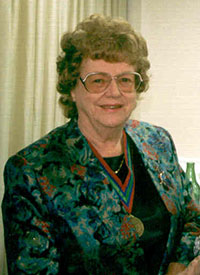 with the passing of Bernice Ina Van Tenac, or Betty as she was known to her family and wide circle of friends. Regrettably Betty had undergone an extended illness and was for five months confined to Royal Adelaide Hospital and later a nursing home in the Adelaide suburb of Welland. During this period, and despite her then physical restrictions, right to the end this wonderful lady retained a positive attitude to, and generated warm greetings and a happy smile for everyone. Her philatelic knowledge and generosity in sharing this with anyone who sought, endeared her with all with whom she came into contact.
with the passing of Bernice Ina Van Tenac, or Betty as she was known to her family and wide circle of friends. Regrettably Betty had undergone an extended illness and was for five months confined to Royal Adelaide Hospital and later a nursing home in the Adelaide suburb of Welland. During this period, and despite her then physical restrictions, right to the end this wonderful lady retained a positive attitude to, and generated warm greetings and a happy smile for everyone. Her philatelic knowledge and generosity in sharing this with anyone who sought, endeared her with all with whom she came into contact.
Betty’s well attended funeral took place on 26th May at her Lockleys family church, St Richards where a commemorative plaque in her memory has been installed. She is survived, and will be sorely missed by her close-knit family: Peter, husband of over 50 years, their three children Mark, Vicki and Shelley, and four grandchildren. To them, the philatelic world extends sincere condolences.
Betty was raised in Broken Hill NSW, for which she retained a lifelong affinity. At the time of her death she was still actively engaged in the preparation of a picture postcard history of that city for entry to Adelaide Stampex 2006. The exhibition committee has agreed to still accept the entry which will be on show between 18 and 20 August.
Those who were close to Betty never saw her inactive. She was always on the go! Betty and Peter together with their son Mark, set up an Adelaide party and bread-making business. As a result of their endeavours, their family concern boomed. It is quite remarkable how Betty managed to successfully combine into her most energetic lifestyle this thriving business, plus her exceptional family commitments, plus philately as well.
Betty took up stamp collecting during the 1960s as a means to entertain her children. Her first clubs were the Woodville Philatelic Society and the Community Philatelic Society in Edwardstown. Since then she has expanded and maintained her enthusiasm for the hobby, and AAT’s first decimal stamp issues sparked her initial detailed interest in photogravure printing. She was a tireless and devoted philatelic worker, both as a collector and educator. Betty loved to encourage other collectors, both beginners and advanced. Even now, Peter still receives mail seeking Betty’s philatelic assistance.
Better known for her internationally acclaimed gold medal thematic exhibit of “Christmas”, Betty was also actively involved in astrophilately “From Sputnik to Spaceship” and traditional Japan. Her detailed variety studies of Australian photogravure printings culminated in special praise for her exhibits of the Queen’s Silver Jubilee and floral coil issues. This interest prompted Betty to co-author with Harold Sheath a highly esteemed booklet on the photogravure printing process. With her 2003 Modern Challenge entry of “US Transport Series Coils” Betty was thrilled to be declared joint winner. More recently, Betty combined her interest in bread and baking with the development of a social exhibit on wheat.
Betty was a qualified national and international thematic judge, and lectured widely on this class of philately. With her seminars, she was able to travel extensively to many exhibitions throughout Australia and abroad. She always expressed particular delight with her many and varied overseas visits to New Zealand, to the Americas: Argentina, USA and Canada, to Europe: Italy and Spain and Asia: India, China, Hong Kong, Japan, Indonesia and Dubai. Between 1984 and 1999 Betty was Australia’s delegate to FIP Thematic Commission. In this capacity she developed a warm friendship with the doyens of thematic philately, Giancarlo Morolli (Italy; FIP Thematic Bureau President 1972 to 2004) and Mary Ann Owens of New York.
Philatelic society memberships included several Adelaide clubs, including the Philatelic Society of South Australia and its associated Commonwealth Specialists’ Study Group. Membership was also held in The Australian Airmail Society and in the Royal Philatelic Societies of both London and Victoria. Betty attained fellowship status with the former.
Perhaps Betty’s widest achievement towards philatelic acclaim – and one for which she will long be remembered – was her prolific authorship, especially in the field of thematics. Her long running monthly advice column in “Stamp News” sparked immense interest and enthusiasm, particularly for the beginner. She was always seeking interesting topics and tidbits to illustrate her column. Many of us can recall lending Betty stamps and postmarks for this purpose. They always came back! Betty also prepared articles for “Philately from Australia”, the American Topical Association and for many years was editor of the Philatelic Association of South Australia’s “Stamp Talk”.
For three years Betty served as the philatelic representative on Australia Post’s Stamp Advisory Committee, the first (and so far, only) woman to have done so. In 1995 she was admitted as a Fellow of the Australian Philatelic Order – again the only female to have so far achieved this honour. Of this Betty was especially proud. And Betty, we are proud of you.
Rest peacefully.
John Gartner, RPD, FAP [1914-1998]
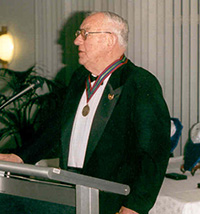 John was born in 1914, became an apprentice to the Printing Trade in 1928, printed his first hand-set type brochures in 1931 and founded the Hawthorn Press in 1936, as a Private Press.
John was born in 1914, became an apprentice to the Printing Trade in 1928, printed his first hand-set type brochures in 1931 and founded the Hawthorn Press in 1936, as a Private Press.
Either by then or some short time later, his interest in philately was aroused, for he joined the Royal Philatelic Society of Victoria in 1946 and today is one of its longest serving members. He was appointed to the Council of the Society in 1953 and became President in 1959, 1973 and 1980. In 1975 he had been made an Honorary Life Member and remained a Council member until 1981.
He is a member of many Philatelic Societies both in Australia and overseas, including the Papuan Philatelic Society, the Collectors Club of New York and the Royal Philatelic Society of London. He was elected an Honorary Fellow of the latter in 1956 and an Honorary Fellow in 1990.
He has served on Australian Exhibition committees at Mipex ’63 as Executive Officer and Ausipex ’84 as inaugural President and Honorary Patron.
John has an outstanding record of service to international philately especially in Asia, where in 1974, with Dr Ichida, he became a co-founder of FIAP (the Federation of Inter-Asian Philately) and today enjoys Honorary Membership of this large and quickly developing Organisation.
His collecting interest has mainly been Traditional philately, having formed many distinguished collections of both National and International acclaim. He gained his first award, a Silver medal at Anpex ’50, but he is best known for his Western Australia which gained Large Gold in 1975 at Madrid and his Fiji gained Large Gold at Philadelphia a year later. Additionally he formed fine collections of Victoria, Queensland, Nauru, Hong Kong and more recently, equally fine collections of Zanzibar and Zululand.
John was appointed to National Juries in Adelaide 1956, Sydney 1959 and 1970, Adelaide 1972 and Jury Chairman Sydney 1980. At International level, he served on juries at Washington 1966, Singapore 1971, New Zealand 1972, 1977 and 1980, Singapore 1987 and in recent years has been appointed Consultant to FIAP Regional Exhibitions including Bangkok 1989 and Kuala Lumpur 1992.
John has also been invited to exhibit in the Court of Honour or provide a Special Display at Exhibitions in Cape Town, Singapore, Malaysia, Wellington and the Collectors Club of New York, where, at the latter he was awarded the Medal for the Best Display and Paper submitted for 1973.
In the field of philatelic literature, John has left a strong legacy of philatelic works printed and published within his company, the Hawthorn Press. Over a 40 year period, all authors were always encouraged, which has resulted in a series of 29 monographs on a wide range of subjects relating to the philately of Australasia. These are acclaimed as a seldom seen series for any aspect of philately and, today, most are considered the authoritative work on their subject.
To this list must be added an extensive range of major Handbooks and Textbooks of Australasia, the Australian Commonwealth Specialists Catalogue and for more than 30 years, the continuous run of Philately from Australia.
In 1973 John assisted in the staging of a “School of Philately” at the Royal Philatelic Society of Victoria and conducted similar weekend schools at both Launceston in 1974 and Hobart in 1975.
It is not commonly known that John was commissioner to many overseas Exhibitions during the 1960s to 1980 (this is the period prior to Australia being recognised by FIP).
In 1965 he was appointed a member of the Australian Commonwealth Stamp Advisory Committee and retired from that post in 1982.
Apart from Honorary or Life Memberships granted to him John has been nationally and internationally awarded many of philately’s highest honours including the JRW Purves Medal 1970, the David Hill medal 1974, both by the Royal Philatelic Society of Victoria, plus the Philatelic Society of NSW Award of Merit 1968 and the Royal Sydney Club J H Smyth Memorial Award in 1984. No doubt the most significant of these honours came in 1975 when he was invited to sign the Roll of Distinguished Philatelists.
The late JRW Purves held John Gartner in such high esteem that in 1963, he dedicated the important philatelic work The Barred Numerals of Victoria to him.
National recognition for distinguished service to philately is an appropriate reward for a man with such an accomplished background, and he is accorded the honour of inaugural Fellow of the Australian Philatelic Order.
[ Source: APF News, July 1995 ]
Postscript
John Gartner passed away on 2 February 1998. A further tribute was published in the February 1998 edition of APF News
H N (Nelson) Eustis, MAP [1915 – 2003]
It is with considerable sadness, we mourn the passing of H N (Nelson) Eustis FAP, on 3rd November 2003, just two weeks after his 88th birthday.
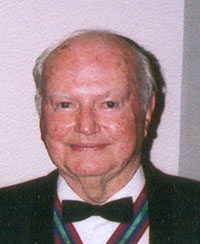 Nelson was born at Queenstown, South Australia, on 21st October 1915, Trafalgar Day, and his patriotic father named him Hamilton Nelson to honour the occasion. It is possible his mother did not think much of Lady Hamilton, and Nelson became the preferred choice of Christian name.
Nelson was born at Queenstown, South Australia, on 21st October 1915, Trafalgar Day, and his patriotic father named him Hamilton Nelson to honour the occasion. It is possible his mother did not think much of Lady Hamilton, and Nelson became the preferred choice of Christian name.
At age ca.10, Nelson began stamp trading at school with selections priced at 1d and 2d each – at this time he was listed in an American collector/exchange ‘pen-pal’ journal.
In 1929, the Perth-Adelaide airmail flight kindled a strong interest in the philately of flown mails and the following year, at age 15, his first article about Australian Airmails was published in Vol I of the Australian Stamp Monthly, under the nom-de-plume ‘Par Avion’. Permission was required from his headmaster to publish the article. In subsequent issues he advertised first Flight Covers for sale at from 1/3 each.
He entered the field of competitive philately in Sydney 1932 in the ‘Under 18 Junior Division’, with a two volume collection of British Empire and Foreign stamps, and when 21 years old, entered his 12 volumes of approx 800 airmail covers of Australasia, in Adelaide 1936, gaining a Silver medal.
In 1931, Alex Rosenblum published the first distinctive account of Australian Airmail Flights and Labels. Nelson soon identified that Australia, and the world, needed a chronological priced catalogue of all aerophilatelic matters within Australia. Following research of newspapers and journals in the early – mid 1930’s, in 1937 he published the first edition of ‘The Australian Airmail Catalogue’ – modelled on the Rosenblum publication, both printed by ‘ASM’.
In 1938, he opened a Newsagency-Hobby Shop in the Adelaide Arcade. It closed 4 years later when Nelson joined the RAAF serving as a Radio Technician and Camera Projectionist in New Guinea, Dutch East Indies, North Borneo and the Philippines. He was discharged in 1945 having gained the rank of Flight Sergeant.
Upon return to civilian life, he opened another Hobby Shop, this time in Gawler Place. Wife Vola and daughters Lynne and Dianne often helped in the shop prior to its closure in 1968.
Following initial publication, the Australian Airmail Catalogue was up-dated over the next 65 years, culminating in the 7th Edition in 2002, during which time the Australian section developed an extraordinary wealth of information re the flights, pilots, labels and vignettes, quantities flown with occasional historic and dramatic references associated with these flights.
Important sections for flights of numerous Pacific Islands were added, many of which Nelson and Vola had actually flown during his extensive travels for business and philately across Asia and the South Pacific.
His need to identify authentic information on world-wide flights associated with Australia soon had him in regular correspondence with leading publishers and collectors around the world including Francis Field, Nicholas Sanabria, Jal Cooper, Ern Crome, Ernie Kehr, Francisco de Silvera, Dr Paganini to name but a few, in some instances, such associations continued until his death.
Closure of the shop in 1968, saw the commencement of Nelson devoting much of his energy to assisting some of the smaller underdeveloped nations, becoming an authoritative consultant to the Post Offices in Samoa, Fiji, Pitcairn Island, Burma, Bangladesh for varying periods of up to 20 years, and an agreement with Australia Post to attend Australian postal matters at exhibitions and events in the Pacific, prior to Australia Post sending its own staff.
He realised that Coin and Stamp collectors all over the world would be interested in collecting coins/stamps from some of these countries if they could obtain them through reliable sources. He believed the royalties from such sales would be a most significant income to these needy countries.
His representation for Richard Borek/MDM of Germany for 20 years took him to visit countries and discuss with the Governors and Deputy Governors of central banks, Ministers or Treasury Officials, contracts for MDM numismatic coins. This particular challenge in his life took him to at least 95 countries, some on more than 50 occasions, and Samoa, nearly 100 times, during which time he met on numerous occasions such persons as the King of Tonga, the Dalai Lama, Tensing Norgay, the King of Sikkim, Aggie Grey, many of whom became the subjects of his other literary pursuits including the autobiography of the King of Tonga.
During his lifetime he found time to promote on a world-wide level, his passion for Australian Aerophilately and his International reputation within those realms became exemplary, being invited to serve on the Board of the Federation of Inter-Asian Philately (FIAP), as Member of the Presidium of the Federation Internationale de Societies de Aerophilateliques (FISA) and a Board Member of the Federation de Philatelie (FIOP) Commission to Aerophilately, while in 1994, he was honoured with the FIP’s most prestigious ‘Research Award’. In the following year, Nelson, along with long time philatelic colleague, John Gartner, was invested as an Inaugural Fellow of the Australian Philatelic Order.
The story of the Nelson Eustis achievements within Australia is well documented through Judging, Exhibition, Society and Committee Management including the formation of the Australian Airmail Society, and many other promotional activities, the breadth of which will not be exceeded.
He perceived the historical significance of many flights and had a fervent desire to ensure they were always recognised. Thus we find many re-enactment flights, vignettes etc in memory of Harry Butler, Charles Kingsford Smith, Graham Carey, Basil Watson, Scotty Allen and Charles Ulm, Ross and Keith Smith to name a few. Added to these names are those of famous aircraft such as ‘Vickers Vimy’, ‘Southern Cross’, ‘Faith-in-Australia’ etc.
Nelson, along with the strong band of Airmail Society members, also recognised major Aeronautical events by the staging of ‘Aeropex 88’, ‘Aeropex 94’ and more recently ‘Aeropex 03’, the latter to commemorate 100 years since the achievements of Orville and Wilbur Wright at Kitty Hawk. Nelson did not see ‘Aeropex 03’, but the work undertaken prior to his passing ensured the exhibition would be very successful. He was sadly missed by all. The late Hamilton Nelson Eustis will be remembered as the doyen, statesman and gentleman of Australian philately, in particular, all matters related to flight.
Wife Vola, his life time partner of 59 years and associate in many business activities, predeceased him by 3 years, and both are survived by their daughters and family, to whom we extend our deepest sympathy.
[ Source: APF News, April 2004 ]
Member (MAP)
(Introduced 1995)
John Moore Member of Australian Philately Citation

In 1992, when John Moore became a Committee Member of the Newcastle Philatelic Society, he began his long and productive service to organised philately.
Since then he has undertaken many functions in organised philately including collecting, exhibiting, judging, philatelic study and research and the promotion of our hobby to the public. Over time he has edited philatelic works, designed and developed philatelic products, and trained other philatelists in exhibiting, judging and organising and running events.
John has been a long-serving member of the Australian Philatelic Federation Executive including Secretary, President Vice President and Public Relations Officer.
He has made a major contribution at the State level having served on the Committee for 17 years. At the local Club level he has held the position of President, Vice President and Secretary.
He has been Secretary and Chair for National and International Exhibitions including Melbourne 2017 where he was Secretary and Australian Commissioner and Melbourne 2022 where he is current Chair of the organising Committee.
John has exhibited in the Traditional, Postal History, Postal Stationery, Modern, Aero, Open, Picture Postcard and One-frame classes. He has achieved Gold medal level at National exhibitions and large vermeil internationally.
Starting as an apprentice in 2012, John has judged extensively at National exhibitions including working as a team leader and Jury Secretary.
His sound judgement and trustworthiness have informed the decisions made by the Philatelic Development Council (PDC) in NSW and the Australian Philatelic Federation (APF) at the national level.
In summary, he has made major and long-term contributions to our hobby.
Anthony (Tony) Deane Presgrave APR, FRPSL, FRPSV, FACCC
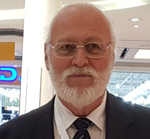
Tony had a childhood collection but started specialised collecting in 1970 and formed collections of Australian Commonwealth, South Australian Departmentals and general issues, River Murray Shipping, Travelling Post Offices of South Australia, Picture Postcards and more recently the Slogan Cancellations of the Adelaide GPO and Postmarking Machines in South Australia. Many of these collections have been exhibited with some achieving Gold and Large Gold medals.
Being a member of over ten clubs and societies, Tony has been recognised with a Fellowship from three (RPSL, RPSV & ACCC) and Life Membership of the Philatelic Society of South Australia. Tony has served continuously on the SA Philatelic Council since 1995 with three separate stints as the Judges Registrar, his current position, amounting to 18 out of the 26 years served to date. In recognition of his services to philately in South Australia, Tony was awarded the Briskham Medal in 1995, the highest award bestowed by the SAPC.
In 2002, Tony received the Australian Philatelic Order Research Award. Author of three books – Albury Postal Services 1975, The Departmental Stamps of South Australia 1992 and The Travelling Post Offices of South Australia 1997, he was also joint author of a fourth, The Railway Parcel Stamps of Australia 1980. Currently editor of two journals, Tony was also Cinderella Corner columnist for Stamp News for 15 years.
Tony has been the APF Frames Project Officer for the last 15 years, Cinderella Class Convenor for the last 13 years and APF Research Officer for South Australia for the last 10 years.
Apprenticed in 1992, Tony’s judging career spans almost thirty years during which time he has judged in every state of Australia except Tasmania. He is currently accredited to judge Traditional, Postal History, Literature, Open, Picture Postcards and One Frame. Tony has been a Team Leader on numerous occasions and was Jury Chair for Adelaide Stampex 2008.
An accredited Commissioner to National Exhibitions since 1992, Tony has also been the Australian Commissioner to overseas exhibitions.
Tony has promoted the hobby through numerous displays and talks at local service clubs, and a periodic display in his local post office culminating in his being instrumental in obtaining Australia Post approval for the issue of postage stamps in 2003 to commemorate the 150th anniversary of shipping on the River Murray system.
Tony Presgrave is well deserving of being recognised as a Member of the Australian Philatelic Order.
DAVID FIGG
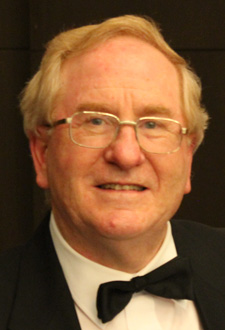
David started collecting stamps during his Primary School years and continued through High School and his early working career when he had pen pals in Fiji & Canada.
Collecting continuously through his Tertiary Studies in Accountancy, it wasn’t until he took an around-the- world trip in 1979 that he became convinced of the need to join a stamp club (or two) – which has now grown to over fifteen clubs.
David became involved in the administrative and organisational side of the hobby in the mid-eighties and has held numerous positions of Treasurer, Secretary, Vice President and President over the years, currently being President of two clubs, Vice President of two, Treasurer of two and Life Member of three. In addition, David has been on both the APF Executive and SA Philatelic Council continuously since 2001, receiving the SAPC Briskham Award in 2006.
At the National level David is currently APF Treasurer, Picture Postcard Class Coordinator, National Juror and FIP Maximaphily Commission Delegate. He has also been President and Treasurer of many National Stamp Exhibitions held in Adelaide.
Internationally, David has been Australian Commissioner on numerous occasions, Commissioner-General for Australia 2013, Vice President to Melbourne 2013 and is currently a Bureau Member on the FIP Maximaphily Commission.
His judging career commenced in 2003. Since then, David has judged on numerous occasions nationally and on overseas accords, and in recent years became a Team Leader in Picture Postcards and has also served as Jury Secretary & Jury Chair.
David exhibits prolifically in the Picture Postcards Class having achieved Large Gold Nationally and Large Vermeil internationally. He has also exhibited in Aerophilately, Open and Polar.
Although not an international judge, it was through his interest in picture postcards that he scored a jury assignment in Finland in 2017. Following that assignment, at the request of Bernard Beston (then FIP Vice President), David prepared two discussion papers for the FIP Board; one on the class being considered as an experimental class, and the other on how to accredit international judges in to the class.
David has also conducted sessions on the class at National Training and Refresher courses as well as seminars and workshops including overseas.
Being a retired accountant by profession, his business acumen and organisational skills have been very much appreciated. For example, David was responsible for organising the Australia-wide insurance policies on Public & Products Liability insurance and the Voluntary Workers Personal Accident insurance.
Darryl Fuller
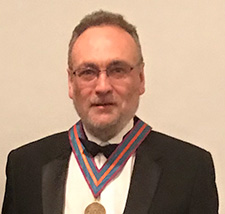 Darryl Fuller has made significant contributions to philately, the APF and the Philatelic Society of Canberra over many years. He was a driving force in ACT philately, receiving the Shakespeare Award from the ACT Philatelic Council in 2018 and being made a Life Member of the Philatelic Society of Canberra. In addition, he is an all-round philatelist‘, a collector, an author, an editor and has been associated with Philatelic exhibitions as an organiser, entrant and a judge.
Darryl Fuller has made significant contributions to philately, the APF and the Philatelic Society of Canberra over many years. He was a driving force in ACT philately, receiving the Shakespeare Award from the ACT Philatelic Council in 2018 and being made a Life Member of the Philatelic Society of Canberra. In addition, he is an all-round philatelist‘, a collector, an author, an editor and has been associated with Philatelic exhibitions as an organiser, entrant and a judge.
Darryl was a member of the Executive of the Australian Philatelic Federation from 2003 to 2018 (as well as seven months over the period 2001-2) including two years as President.
He has been a member of the Philatelic Society of Canberra for more than 30 years, serving on its Committee for much of that period, as well as being a member of the executive of the ACT Philatelic Council for most of that time. He has held a number of positions in both organisations including President and Vice-President of both organisations.
In a remarkable achievement, he has been Chair of the Organising Committees of no less than 9 National and Part-National Philatelic Exhibitions (Canberra Stampshows) held in Canberra since 1990 including the full-national exhibition Natstamp 98. In addition, he has been a member of the organising committee on three other national exhibitions and was involved in the organisation of two international exhibitions held in Australia.
He is a national (postal stationery, aerophilately and revenues) and International philatelic judge (postal stationery) and is currently the Australian representative on the FIP Revenues Commission and a Bureau member.
He has formed an International Gold Medal collection of Leeward Islands Postal Stationery which won the Grand Prix d‘Honneur at the Asian International exhibition Nanning 2016 as well as forming significant exhibits in aerophilately (to Gold at National Level) and revenues (to Vermeil at National Level) and exhibiting in literature.
Darryl has written many articles on philatelic subjects including postal stationery, exhibiting and aerophilately as well as a series of articles on behalf of the Australian Philatelic Federation in Australasian Stamp News. He was editor of Capital Philately, the Journal of the Philatelic Society of Canberra, for over 10 years.
Charles Bromser

Charles Bromser (L) with Stephanie Bromser (R)
Charles has been involved with Organised Philately since the 1970‟s. He has been a member and served on the committees of many local and national societies and organisations. Charles was the Secretary of the Australian Philatelic Federation for four years and has served internationally in the Astrophilately and Thematic fields as delegate and bureau member with the FIP. He has also served on the committees of numerous state and national Stamp Exhibitions, including the upcoming Melbourne FIAP 2017 Show.
Charles is the author of many philatelic articles and edited Philatelic Journals, both nationally and internationally, including being a Webmaster. He has formed and exhibited excellent philatelic exhibits, achieving some of the highest awards. Charles is a National, FIAP and FIP judge, and has presented Seminars at exhibitions, as well as serving as an International Commissioner. He has been involved at school level with Philately, helping the future generations to become involved in this wonderful hobby.
Charles Bromser is a complete and all-round excellent Philatelist, well-deserving becoming a Member of the Australian Philatelic Order.
Dr Geoffrey Lewis, MAP
Dr Geoffrey Lewis is an all around philatelist, an inveterate collector, a high level philatelic researcher particularly in the field of postal history and a strong supporter of organised philately.
Dr Lewis has given many years of service to the Philatelic Society of NSW initially as Vice President and subsequently as President and now Treasurer. He established the Society’s Postal History Group that over time became the Chatswood group which still has an emphasis on postal history.
Dr Lewis has been Chairman of two successful national exhibitions staged in Sydney both at the Royal Randwick Race Course. He was the inaugural Chairman of the New South Wales Exhibition Standing Committee (NESC) which oversights the organisation and conduct of exhibitions in New South Wales.
In his collecting interests Dr Lewis started with the Spanish Philippines and subsequently moved on to Cuba, another Spanish colony. He is one of the few overseas members of the Spanish Academy of Philately. Dr Lewis is best known as a postal historian but he has collections of the stamps of the Philippines and Philippine International airmails.
Dr Lewis is a judge at Australian National Level and is also an FIP accredited judge in Postal History and Traditional Philately. He readily imparts his knowledge on exhibiting to other exhibitors. On 27 April 2014 he presented a session at the Malmö 3rd International Philatelic Summit in Malmö, Sweden on Postal History Collecting and Exhibiting.
The Australian Philatelic Federation has assigned Dr Lewis as a national commissioner to Espana 2006 at Malaga and Italia 2009 in Rome. The Philatelic Development Council of PHILAS appointed him as the Commissioner/Judge and Coordinator of the Australasian Challenge, Baypex 2014.
Dr Lewis has co-authored a monograph on the Postal History of the Spanish Philippines. Corinphila has also published hi collection of “Stampless Mail entering Spain” as part of their Gold Edition series.
Geoffrey Lewis is an accomplished member of the philatelic community who has served organised philately over many years, is distinguished in Philatelic study and research, a well respected judge and teacher of exhibitors both here and overseas and a strong promoter of our hobby to the general public.
John Bell
John Bell has been a stamp collector since he was a young boy, first collecting the world as all young people do, then in his teens the British Commonwealth King George VI period.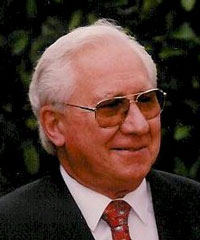
While living in Victoria during the 1960’s he started collecting postmarks and would drive around the State posting letters to himself. About 1964 he purchased the Robson Lowe Encyclopaedia of British Empire Stamps, Volume IV, The Empire in Australia. This was the turning point from his being a collector to becoming a philatelist.
On returning to South Australia in 1971 he was persuaded to attend Stamp Club meetings with a person who has since become a very close friend. The introduction to organized philately subsequently led to his involvement with the South Australian Philatelic Council, to exhibiting and to judging.
John was SAPC President from 1994-1997, was re-elected in 2006 and still holds that position. He was awarded the Briskham Award for Service to South Australian Philately in 1996.
The highlight of exhibiting his South Australian Postal History was being awarded the Grand Prix at Canberra, and International Gold at London and Auckland, all in 1990. This exhibit was sold in 2001 which has enabled him to build an exhibit of Portuguese Postal History and which has been accepted for both London and Lisbon this year.
John attended the first APF judging school in Canberra and served his apprenticeship at Adelaide Stampex 1986. This has led him to judging in many National Exhibitions around Australia which he enjoys, also appreciating the opportunity to look at the displays and exhibits in all disciplines.
His positive approach and encouragement at all levels of philately is appreciated by all.
Ian McMahon, MAP
Ian McMahon began schoolboy collecting in his home State of Queensland. However his philatelic prowess and skills blossomed when he moved to the national capital and joined the Philatelic Society of 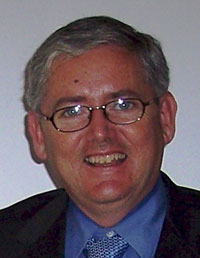 Canberra in 1978. Since that time his contributions to organised philately at Local, State, National and International level have been outstanding. These include:
Canberra in 1978. Since that time his contributions to organised philately at Local, State, National and International level have been outstanding. These include:
the Council of the Philatelic Society of Canberra from 1986 to present in many roles including President 1991-94 and from 2009;
the ACT Philatelic Council 1989-present, President 1991-99 and from 2002-present;
the APF Executive from 1996-09 in a variety of roles including President 2003-05 and Secretary 2007-09;
a Bureau Member of the FIP Postal Stationery Commission since 2006.
He brought to all these positions dedication and enviable administrative skills always accompanied by quiet, unruffable efficiency.
Exhibiting & Judging
Ian has a diverse range of collecting interests and is a regular exhibitor at National Shows in Australia and New Zealand as well as at FIAP and FIP Exhibitions. His major interest and successes are those of Postal Stationery especially of Canada, New Zealand and modern Australia. He qualified as a judge at State level in 1996, at National level in 1999 and as Postal Stationery judge with FIAP in 2008 and with FIP in 2009. He has been a jury member at numerous national shows, often as Chair or Secretary, and is qualified to judge in a range of classes. Canberra is unique in that commencing in 1980 it launched a continuous series of major biennial shows and Ian has played a major role in the organisation of all of these events since 1988. He is also an experienced and widely travelled Australian Commissioner to a range of FIAP and FIP shows. Ian is always prepared to assist with training courses for new exhibitors and judges at all levels of competitive philately.
Research & Publications
Ian has been a prolific contributor to a range of journals and his bibliography of articles and monographs since 1987 lists over 200 entries. These included Australian and overseas publications as diverse as archival research into early Queensland railway postal rates to APF brochures such as `I have just inherited a stamp collection’. Especially praiseworthy is his association with the Postal Stationery Society of Australia; he has been the driving force and editor of its journal, the Postal Stationery Collector, since its inception in 1995. His personal contribution to listing and describing items of modern Australian postal stationery deserves special note.
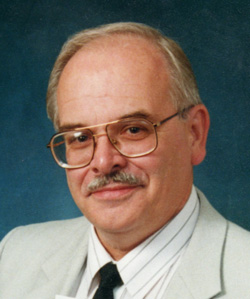 Michel has been collecting stamps for nearly 60 years. He has been a regular exhibitor for 29 years and a National Judge for 22 years. He has been on stamp club committees in 3 countries and has been a Club Delegate to the South Australian Philatelic Council since 1979, serving on the Executive for the past 15 years. He has been involved in drafting the current SAPC Constitution, Replaceable Rules and all By-laws to date. Michel was awarded the Briskham award for service to South Australian philately in 1997.
Michel has been collecting stamps for nearly 60 years. He has been a regular exhibitor for 29 years and a National Judge for 22 years. He has been on stamp club committees in 3 countries and has been a Club Delegate to the South Australian Philatelic Council since 1979, serving on the Executive for the past 15 years. He has been involved in drafting the current SAPC Constitution, Replaceable Rules and all By-laws to date. Michel was awarded the Briskham award for service to South Australian philately in 1997.
In 1981 Michel was chosen as a member of a select group of four people to organise and conduct the first State Philatelic Judges Training Course, an extensive induction with monthly seminars that ran for 18 months. Most of the graduates went on to become accredited National Judges.
For a period of 12 years Michel was the South Australian Judges’ Registrar, responsible for identifying and training State judges, maintaining their accreditation, and providing judges at club and state competitions.
As well as being an exhibitor, judge, commissioner and administrator, Michel is also an occasional philatelic writer and has been the editor of the SA Frama Study Group Journal since 2004.
For the past 30 years Michel has been a trainer and mentor for youth and adult collectors as well as judges in South Australia. He has also been invited to speak and conduct philatelic training courses in several states.
He is currently the APF One-Frame Coordinator.
Michel’s successful exhibiting career started in 1982 and he first exhibited overseas in 1984. Michel has formed extensive collections of Belgium (all periods in several classes), Australia (WW2 postal history and research exhibits and modern era) and Papua New Guinea. To date he is the only exhibitor to have won the Australia Post Cup twice (2005 and 2009). He was a pioneer in Social Philately, debuting at Canberra Austamp 90 and gaining an international Large Vermeil at Australia 99.
Michel has been an ardent supporter of philatelic exhibitions in South Australia since Stampex 86 and has developed philatelic products for all exhibitions since 1999, as well as serving on their committees. Michel has been the South Australian Coordinator for all five State Challenges so far.
Michel is passionate about his hobbies and he is a driving force for the recognition of the place of picture postcards in exhibitions. Michel has exhibited picture postcards to International level and won several Gold medals with his many exhibits.
Dr Geoffrey N Kellow
 Dr Geoffrey Neil Kellow (FRPSL, APR) – Member Dr Kellow is a philatelist who joined our hobby at an early age and continued with it. In his developmental period in Melbourne his mentors included J.R.W. Purves and later Phil Collas.
Dr Geoffrey Neil Kellow (FRPSL, APR) – Member Dr Kellow is a philatelist who joined our hobby at an early age and continued with it. In his developmental period in Melbourne his mentors included J.R.W. Purves and later Phil Collas.
Dr Kellow is best known for his work in Philatelic Literature and the organisation of philatelic libraries. He used this background to research numerous areas and has made his knowledge widely known.
Dr Kellow has assisted numerous exhibitors and collectors (especially in Melbourne and Sydney) form their collections with detailed and knowledgeable advice, support and guidance. He possesses an extensive library on the Philatelic literature of the British Commonwealth. He is generous with these resources to serious collectors. Evidence of this is found in the many times his work is quoted in journals, books and in particular in auction catalogues when referencing or describing unusual and rare varieties.
As a consequence of his major work The Stamps of Victoria (1990) which was prepared over a seven year period, Stanley Gibbons Ltd revised and re-numbered their published listing of Victoria in their British Commonwealth Part 1 Catalogue over seven separate editions (1992-98).
Dr Kellow has written hundreds of research papers on subjects as diverse as printing methodology, postal rates, plate making techniques, maritime history, marcophily, paper, ink/shades, plate varieties, postal treaties, combination franking, interpretation of official archives, census data and a very large volume of indexes on a multitude of subjects. Much of this research concerns both the Colonial and Commonwealth philately of Australia.
His work will be found over a period of approximately the last 30 years in journals in both Australian and the United Kingdom.
Further, Dr Kellow has undertaken extensive research in the archives of the Victorian State Government (Melbourne), The State Library of Victoria (Melbourne) on the philately of Victoria. For the Commonwealth period his has researched the archives of the Reserve Bank of Australia (Sydney), ANZ Bank (Melbourne) and Australia Post Headquarters (Melbourne). This work has lead to the Australian Commonwealth Specialist Catalogue being revised. The inclusion of archival information has increased the stature of this publication.
Current projects include an electronic database of the libraries of The Royal Sydney Philatelic Club, The Philatelic Society of New South Wales and The Philatelic Association of New South Wales (approximately 20000 individual items) all fully cross-referenced to that of The Royal Philatelic Society of Victoria.
In support of philatelic libraries he has also donated many hundreds of books, priced catalogues, journals, indexes and auction catalogues over a 30 year period to both The Royal Philatelic Society of Victoria and The Philatelic Association of N.S.W.
Dr Kellow has also been involved in the production of a number of books published by The Royal Philatelic Society of Victoria which has kept Australia in the forefront of philatelic literature.
Club membership assists in achieving what Dr Kellow has attained. He is best known for his membership of the Royal Philatelic Society of Victoria on which he served for over 25 years. His work on the issues of the Australian Commonwealth led him to join the Australian Commonwealth Collectors Club on which he has served on the Executive and of which he is currently President.
Dr Kellow is a well rounded philatelist who generously shares his knowledge and supports others.
Special Note: In 2009 Dr Kellow was invited to the sign the Roll of Distinguished Philatelists.
Hans Karman
 Hans Karman has contributed to Australian Philately at local, state, national and international levels.
Hans Karman has contributed to Australian Philately at local, state, national and international levels.
His service as Exchange Superintendent of the Philatelic Society of Canberra, and as a member of the Society’s Council, for a period of over twenty years represent an outstanding contribution to local philately. His skills in the role were outstanding and soon after his appointment Hans prepared a computer program to handle the exchange branch circulation and its accounts. He pioneered the sending of a selection of books to several smaller stamp clubs in southern NSW, a service that continues today.
Hans Karman was elected to the ACT Philatelic Council in 1984 and immediately assumed the post as Treasurer which he held until 1992. Besides his work as Treasurer, he playing lead roles in two major APF Projects and contributed to State judging and exhibiting courses. His contributions to the courses have specifically concerned presentation, mounting of exhibits and postal history.
He has been actively involved with Canberra Stampshows including the 2002, 2004 and 2006 modified National Exhibitions and was Treasurer of Austamp 90, a full national exhibition. Hans Karman became a National judge in 1997 being qualified to judge postal history, social and postal stationery.
Hans Karman has been an active philatelic exhibitor, researcher and writer. He has exhibited nationally and internationally with his major exhibit Free Mail of Australia – States and Commonwealth attaining Gold medals at international exhibitions, each time with a completely redesigned exhibit. He also exhibited in Social Philately, Postal Stationery and, more recently, Postcards.
His exhibiting and archival research on Australian free franks resulted in a greatly increased understanding and interest in this material. Hans virtually single-handedly raised the topic from an unrecognised byway to an accepted major field of colonial philately. His monographs include An illustrated catalogue of the free markings and frank stamps of the Australian Colonies and Australian privileged mail 1830s to 1920. In addition he has published many research articles on aspects of postal history in Australian and overseas Journals. He produced an index of The Informer, the Journal of the Society of Australian Specialists – Oceania. He has also been an active writer on exhibiting and the use of computers in Philately.
[ Source: APF News, August 2005 ]
Linda Lee
 Linda Lee has created a legacy in the areas of Youth Development and promotion of Thematic collecting. Linda is one of a few women who have served at Club, State, National and International levels.
Linda Lee has created a legacy in the areas of Youth Development and promotion of Thematic collecting. Linda is one of a few women who have served at Club, State, National and International levels.
Linda has served at Club level as a Committee member of the Philatelic Society of NSW. Her long-term service at Club level was as a founding member of the Thematic Society of Australia in 1978 and as Secretary from 1980-1985 and as journal editor from 1995-2002
In 1995 she accepted an invitation to join the NSW Stamp Council where she has served as Vice President and has been Secretary since 2002. She has been a member of various subcommittees of the Council – awards, policy development, judges’ training. She was also part of the team that organised and carried out the amalgamation with the Philatelic Association of NSW (Philas) which resulted in the Stamp Council becoming the Philatelic Development Council. From 1995 to 2001 Linda was a member of the APF Executive covering the portfolio of Youth Development. As an educator she brought vitality to this area. During her tenure a number of initiatives were undertaken. State Youth leaders were brought together biennially to discuss future directions. A full colour magazine aimed at young collectors was developed and continues to this day. Support of youth exhibitors was undertaken by supporting selected young people to travel to International Youth Exhibitions. A Youth Leaders Kit and a Youth Exhibitors kit were developed and distributed to State Youth Officers. A Youth exhibitors mentoring program was started.
In 2000 Linda led a committee to develop criteria for a new APF national award which became the SPAN (Special Achievement at National level in Philately) award. The SPAN award is the only one rewarding outstanding service at the national level in a specific philatelic area. The first were presented in 2002.
In 2001 she developed, organised and conducted a national youth stamp design competition for the APF to celebrate the Centenary of Federation. Starting at local level this moved on to State and finally National level. The winning designs were displayed at the Brisbane Centennial Stampshow 2001.
Linda’s collecting base is Thematics. Her major exhibit “Women in Society” celebrates the many roles of women in society. Linda’s other interest is gardening and it was no surprise that her second thematic exhibit was “Flower Magic”. Linda participated in the APF’s French Colonies Challenge with an entry on “Algeria” and the Dot Com with an entry on modern Australian stamps – both continue to be developed. She has also successfully tried her hand at One Frame exhibiting with a traditional entry, “Pioneer Life”. Linda’s expertise in the exhibiting classes Thematics and Youth has meant that she has been part of these national judging teams. She also successfully apprenticed as an International judge in the Youth Class at Bangkok 2000.
In 1999 and 2000 she was Secretary to Olymphilex 2000, an exhibition of Olympic collectibles held in conjunction with the Sydney Olympics. Linda had to co-ordinate a team whose members were based in Lausanne, Brisbane, Melbourne, Canberra and Sydney.
She has given seminars on thematic exhibiting and judging in Australia and in 2001 in New Zealand and regularly gives displays of her collections to NSW clubs and societies.
Linda Lee has shown what an educationalist with a feminine touch can achieve in Australian Philately. She has pursued her interest in Thematics in collecting but has been willing to look at other areas such as Traditional Philately. Her vitality and innovation reinvigorated the area of Youth Development.
[ Source: APF News, August 2004 ]
Malcolm Groom, MAP
 Malcolm Groom has been a stalwart of organized philately in Tasmania since first becoming a member of the Tasmanian Philatelic Society some 37 years ago, during which time he served as President [1983-84], Treasurer [1980-82] and long-time committee member – his service being recognized by the awarding of Life Membership. Since 1987, he has served on the Tasmanian Stamp Council, and since 2001 as its President. Malcolm chaired the Organizing Committee of the PHILITAS ’89 State Exhibition and more recently the successful TASMANIA 2003 National Exhibition.
Malcolm Groom has been a stalwart of organized philately in Tasmania since first becoming a member of the Tasmanian Philatelic Society some 37 years ago, during which time he served as President [1983-84], Treasurer [1980-82] and long-time committee member – his service being recognized by the awarding of Life Membership. Since 1987, he has served on the Tasmanian Stamp Council, and since 2001 as its President. Malcolm chaired the Organizing Committee of the PHILITAS ’89 State Exhibition and more recently the successful TASMANIA 2003 National Exhibition.
Malcolm gave 10 years’ dedicated service to the APF as its Philatelic Development Officer [1987-89], Treasurer [1989-91], Vice President [1995-97], President [1997-99] and IPP [1999-2001]. His skills have been used as a presenter for the APF’s Executive Development Program, and 2002 National Judges’ Training Course.
Malcolm is currently in his third year as Secretary-General of FIAP. He has been a member of the FIP Postal History Commission since 2000 and during last year appointed as Chairman of the Organizing Committee of Australia’s third FIP Exhibition, PACIFIC EXPLORER 2005.
In the area of philatelic study and research, Malcolm has formed several notable collections. Foremost among them are his Tasmanian Postal History to 1912 [FIP Large Vermeil and National Gold], Postal Stationery of Tasmania [FIP Large Vermeil and National Gold], Australian Contract Mails [FIP & FIAP Large Vermeils], Tasmanian Sidefaces & Tablets 1870-1912 and Tasmanian Pictorial Issues 1899 [both National Large Vermeils].
It will be clear from the aforementioned exhibits that Malcolm has a passionate and abiding interest in Tasmanian philately – both traditional and postal history. This has led to his co-authorship and contribution of articles in numerous exhibition catalogues and journals.
Malcolm has served on 12 Australian National Exhibition juries since 1986, which included being chairman in Brisbane 2001. Malcolm served his FIP jury apprenticeship in London 1990, and subsequently served on overseas juries at Indepex 1993, Norwex [Oslo] 1997, London 2000, Hong Kong 2001 and Philanippon [Tokyo] 2001.
Malcolm has acted as Tasmanian State Commissioner on 8 occasions and as a National Commissioner to China 96, Hong Kong 1997, Bangkok 2000 and España 2000. The experience so gained equipped him well to be a presenter at the National Commissioners’ Courses in 2000 and 2003.
Malcolm has been a member of Australia Post’s Stamp Advisory Council since 1999, and the APPMAC Committee from 1999-2001.
Malcolm’s wide and valued contribution to Australian Philately strongly supports his membership of the Australian Philatelic Order.
Tom Frommer
Tom Frommer has been an active member of the Philatelic Society of Canberra since about 1960 and for the past eight years has been a member of the Council of the Society, and sometime Publicity Officer.
His many other contributions to organised philately include being a member of State and National Exhibition Committees since 1996 – Canberra Stampshow 96, Natstamp 98 [full national], Canberra Stampshow 2000 [part-National], and Canberra Stampshow 2002 [Australasian Challenge]. He served as Bin Room Manager in 1996 and as Exhibition Coordinator in 2002.
He has been a member of the ACT Philatelic Council for 6 years.
Tom has been the ACT representative to NAPE (interNational Association for Philatelic Exhibitors) since 1997 arranging meetings and promotion of the society in the ACT. Behind the scenes, his responsibilities for the NAPE journal have increased since the passing of Ed Druce, including organising the mail out of the quarterly journal.
Tom is considered one of the two leading Australian aerophilatelists in respect of both collections and research of Australian and PNG airmails (the other being Nelson Eustis, FAP). His distinguished collections include:
· Australian Contribution to the Development of World Airmails 1914-1936: 3 International Large Gold medals : Istanbul 96, Israel 98, The Stamp Show [London] 2000 and Australian Grand Prix Award at Aeropex 94 in Adelaide.
· Airmails of Papua & New Guinea: FIP Large Vermeil [Singapore 95, Norwex 97, China 99].
· Famous Pilots & Famous Flights: Gold : Stampex 99
· Airmail Labels & Vignettes of Australia 1920-60 : Vermeil [Singpex 98].
Tom was the Assistant Editor of the Australian Air Mail Catalogue for the 1990 and 1997 editions, and a 2002 edition is also being produced. This catalogue is widely regarded as the definitive work on Australian and Papua New Guinea air mails.
Tom is Author of the Catalogue of Australian Air Mail Labels and Vignettes 1920-1960, published in 1995. He has also contributed numerous articles in various airmail society magazines.
Tom has been an accredited national judge in aerophilately since 1993 and subsequently in Social Philately. In 2000, he became an accredited FIP judge in aerophilately. Has acted as a national judge and team leader in aerophilately at a number of national exhibitions in Australia and New Zealand. Since the mid-1980s he has participated in State Judging Training Courses in the ACT and has arranged State training courses for Exhibitors every 2-3 years since the mid-1980s.
John Crowsley
John Crowsley has been a stamp collector since his youth. He became involved in organised philately in the early 1970’s. He has been a member of The Philatelic Society of Queensland Inc, formerly the Queensland Philatelic Society for about twenty five years, holding the office of Secretary / Treasurer from 1978 until 1989. He was elected President in 1989, serving in that capacity until 1991, and again in 1994 and 1995. He was elected Treasurer in 2000 and still holds this position.
John is first and foremost a thematic collector, enjoying the challenge of acquiring knowledge and philatelic items to illustrate his chosen themes; the most notable being “Elephantasia” which has achieved a National Large Vermeil Award (Natstamp 98). “Cats” both domestic and wild and “Merchant Shipping” together with “Kangaroos”, form his other thematic interests. Other collecting interests are Great Britain Postal History, Aden – Ship Mail and all aspects of Norway.
Prior to the formation of the Queensland Philatelic Council, John was involved with the Philatelic Association of Queensland, the parent body for clubs in Queensland. He served as Secretary and Treasurer in the late 1970’s becoming President in 1983, an office he held until the PAQ and the Queensland Stamp Promotion Council became the Queensland Philatelic Council Inc in September 1985 – a smooth amalgamation due in no small part to John’s liaison work. He became Vice President of the new body and at the first Annual General Meeting was elected President, serving for the constituted term of two years – 1986 to 1988.
From 1992 to 1995 he served as Philatelic Development Officer of the Australian Philatelic Federation. This office involved such projects as Archival Collections, Library Recording Scheme, APF Handbook and an Exhibiting Handbook.
He is also Archival and Library Officer for the QPC which entails research into queries from out of State and overseas. John compiled “Queensland Philatelic Society – 1921-81” and it was entered in Anpex ’82 where it received a Silver Bronze Medal. This publication was updated and completely rewritten under the title “Queensland Philatelic Society – The First Seventy Five Years 1921 – 1996” and entered into Sydney Centrepoint ’95 where it again received a Silver Bronze. He has been associated with The Queensland Stamp Collector since its inception in January 1984, when he was Distribution Manager, becoming co-editor during 1995, remaining in charge of distribution and at the AGM in September he became Editor, still in charge of distribution. He holds this office today. When an Editor was needed for Thematically Speaking in January 1999, John added this to his portfolio. He writes the Editorial for both magazines. John as been a regular guest speaker at the PSQ and society meetings in south east Queensland for many years. His talks are always informative and at times humorous.
Together with another QPC member he organised and ran seminars at what was then known as TAFE, and jointly organised and conducted judges’ training courses during 1995, 1996 and 1999; he also jointly ran an exhibitors course, for interested persons, in 1997 and 2001.
However, it is in exhibition organisation that John really shines. He is a State and National level judge with qualifications in the Thematic and Postal History classes. His expertise as Floor Manager and Exhibits Coordinator have been used at State and National shows in Queensland since 1981, with outstanding success. He has served as a Commissioner for National Exhibitions here and in New Zealand, and a FIAP Exhibition.
John does his jobs in a quiet way, and not saying much, but when asked always has a sensible opinion on all matters philatelic.
Michael Blake
 Michael Blake has a long and distinguished record of service and contribution to philately in Australia.
Michael Blake has a long and distinguished record of service and contribution to philately in Australia.
His service to organised philately began in 1960 as a member of the Southern Districts Philatelic Society where for ten years he was vice president and a committee member. He became a founding member of the Postal Stationery and Postal History Society in 1976 and held high offices of that Society for over thirteen years. His memberships and contribution to Societies extended after that to Societies in the UK, Fellow of the Royal Philatelic Society, London, British Society of Australian Philately and the Collectors Club New York. He is a member of many significant National Societies including as Chair of the South Australian Study group since 1991.
He has been an active member of the APF executive as Treasurer for eight years. During that time he has also acted as APF coordinator to several National exhibitions and served on the organising committees of Stampex 86, 91 and 97 and is currently the Jury Chairman and other positions on the Committee for Adelaide Stampex 99.
Michael’s international service to philately includes being the Australian delegate to the FIP Congress in 1993, 1996 and Commissioner to China 96 and Philexfrance 1999. After acting as Australian delegate to the Traditional and Revenue Commissions of the FIP he was elected as a member of that Commission in 1996. He is very active in conducting seminars on traditional philately.
Michael has a number of fine collections which have received high awards Nationally and internationally. He is probably best known for his Tasmanian postal history collection which has been awarded the National Grand Prix in Sydpex 88 and three international gold medals. His New Zealand 1898 Pictorials have received three international large vermeil and a national large gold and he also exhibits South Australia and Tasmania traditional collections. He is also developing collections in Australia military postal history and French Somali coast.
His judging apprenticeship occurred in Cuppex 1987 and since then he has achieved qualification as an FIP accredited Traditional judge serving in Australia 99 and Ibra this year. His National jury service included Secretary to the Jury in Sydney 1995.
Since 1989 Michael has maintained the South Australian philatelic database on behalf of the South Australian Study group and has published work in the Shilling Violet, London Philatelist, Posthorn and Philately from Australia.
Michael is principally responsible for the initial design, sourcing, advertising and administration of the range of philatelic products sold by the APF and was responsible for the production of the first two volumes of the APF notable collections series. These products raise significant income for the APF each year.
He is very active in the conduct of training programmes and teaching seminars. He ran a two day training session on Traditional exhibiting and judging at Canberra in 1998 and will be conducting a significant part of the course in Adelaide in 1999. He has been a frequent speaker at Probus, Rotary and South Australian stamp clubs over a period of years and has given displays at clubs outside South Australia.
He played a prominent role in the establishment of Saphil House and in 1995 was received the Briskham Award for services to South Australian philately.
Michael Blake’s wide contribution to Australian and international philately strongly supports his Membership of the Australian Philatelic Order.
[ Source: APF News, October 1999 ]
Joan Orr
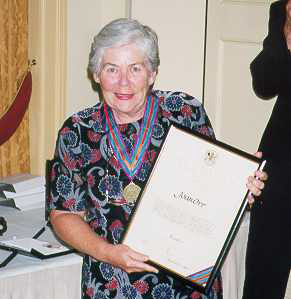 The fascination of stamps began for Joan at the age of seven. Over the years since then she has amassed a considerable knowledge of philately and provided great support to the hobby through her administrative efforts.
The fascination of stamps began for Joan at the age of seven. Over the years since then she has amassed a considerable knowledge of philately and provided great support to the hobby through her administrative efforts.
Her collecting interests are best known through her exhibits of China Airmails which has achieved an international large vermeil at Praga 88, her Thematics exhibit titled ‘The Swan’s Story’ which has been awarded two large silver medals and an exhibit of the Priority Paid mail system which received large vermeil at Thaipex 89. Recent exhibits include the Australian Navigator series 1963-1973 which was awarded a large vermeil with felicitations at Natstamp 98. Her ‘Printed to Private Order’ exhibit was given a vermeil and special prize at Brisbane Stampshow 91. These collections give a sense of the breadth and quality of Joan’s collecting interests.
Joan became an accredited national judge in 1988 and is qualified in all the principle disciplines having judged at twelve National exhibitions. She is also an accredited FIP judge in the Youth field and has judged at Brasiliana 93, Indonesia 96 and Juvalux 98.
Joan’s service to philately includes acting as Commissioner to four International exhibitions and seven National exhibitions beginning as Commissioner for Papua New Guinea in 1982 to Anpex. She has been a member of the organising committee for five National exhibitions and was the Australian delegate to seven international youth conferences.
Joan has given sterling service to Queensland philately. She has served on the State council for the past fifteen years and has held multiple executive positions each year. A highlight was two years as President from 1988 to 1990 and Secretary from 1992 to 1999. She supports many local stamps clubs and was instrumental in establishing two at Cairns and Nanango. It has been tallied up that she has spent more than 140 years in general membership of stamp clubs and 27 years on committees.
She is in demand to present displays and to judge at club competitions and local Shows. She is always willing to share her knowledge with others and has conducted youth workshops since 1986 and jointly conducted and presented Adult seminars, exhibitors workshops and judges training courses since 1993.
Joan Orr gives a great deal of her time in supporting philately and others in the hobby through her energy, knowledge and dedication.
[ Source: APF News, October 1999 ]
David Benson
David Benson has been a longer term supported of Australia philately. He is well known in the Sydney philatelic scene at both club and State level. His service to commercial philately have allowed many other philatelists to build their collections. David has a long association with Exchange Branch activities. In recent years he developed the concept of club postal history auctions which has generated increased membership for the Philatelic Society of New South Wales. David has on a number of occasions brought forward ideas which have increased membership in a number of clubs. He has served for many years as librarian of the Royal Sydney Philatelic Club.
At State level, David has been a long term member of the Philas executive serving as treasurer and on the committee. He has been part of a team which since 1975 built Philas Auctions into a major supplier of material for Australian collectors. David received the Philas Medal for Service in 1986.
Since 1970 exhibition committees in Sydney have carried the name of D Benson. David is a State, national and internationally accredited judge. In 1985, David was Australian Commissioner to Israphil-85, one of the first generation of national commissioners. He was Executive member of Anpex 1970, Sydpex 1980, and Sydpex 88. In 1986 he and his wife began an association with Asian philately. David has been a stalwart of the Pacific Islands Study Circle of the Royal Sydney Philatelic Club. He collection of Tonga is of a high standard and he has researched the early mails systems of that island nation. His knowledge of 19th century philately is extensive.
David has always been available to talk to clubs and through his wife has a keen interest in the development of youth philately.
John Sinfield
 John Sinfield has been a keen stamp collector for more than thirty years and a regular exhibitor since 1980.
John Sinfield has been a keen stamp collector for more than thirty years and a regular exhibitor since 1980.
John has formed and continues to develop important and notable collections in several disciplines including thematic philately where his Whiskers exhibit has won several international and national gold medals. It has been exhibited in the Court of Honour at Taipei 96, a FIAP exhibition. His has assembled various exhibits of postal stationery which have won international gold medals at FIP exhibitions at Brasiliana 1993, Finlandia 1996 and Indepex 1997. He won the Grand Award at Newcastle 1997 and the Grand Prix National at Natsamp 98 in the postcard class. John currently has five different FIP 8-frame qualified exhibits.
John has been an accredited national judge since 1989 and is qualified in the postal stationery, thematic philately, traditional and youth classes. He has judged at five Australian and several New Zealand national and one-frame national exhibitions including being a team leader at Northpex 92, 93 and 94 (New Zealand) and at Melbourne 96.
Behind the scenes, John was Bin Room Assistant at Ausipex 84 and Treasurer to the 1989 Stampshow in Melbourne. He was also Vice President of the Melbourne 96 National Philatelic Exhibition. Since 1992, John has been a commissioner to several exhibitions within Australia and New Zealand as well as national commissioner to three FIP international exhibitions: Genova 1992, Istanbul 1996 and Italia 98.
John has been a member of the Royal Philatelic Society of Victoria since 1976 and has served on its Council for 14 years from 1977-79 and again from 1988. He was secretary for two years (1997-98) and President in 1996-97 as a delegate to the Victorian Philatelic Council for eight years between 1986 and 1993. John was awarded the Victorian Philatelic Council Award of Merit in 1996.
John Sinfield has served on the Executive of the APF between 1989 and 1992 and was secretary between 1989 and 1991. He has twice represented Australia and New Zealand at FIP Thematic Commission meetings as a substitute delegate. He was also the philatelic representative for a five year term on the Stamp Advisory Committee of Australia Post.
John has been a contributor to publications such as Philately from Australia, Postal Stationery Collector, The Date Stamp, Thematics Queensland and the Australian Commonwealth Specialists Catalogue. In addition, John has undertaken archival postal stationery research which will be the major contribution to be incorporated into the forthcoming Australian Postal Stationery Catalogue which is currently in the course of preparation as part of the Brusden White Specialist Catalogue series. John has lectured in postal stationery and thematic philately at the Royal Philatelic Society of Victoria School of Philately in 1996. He has also lectured overseas at Northpex 94 (New Zealand) and at Taipei 96. His other promotional work has included radio and a weekend feature article on philately which appeared in the Melbourne Herald-Sun.
[ Source: APF News, October 1998 ]
Kevin Ryan (1926 – 2004)
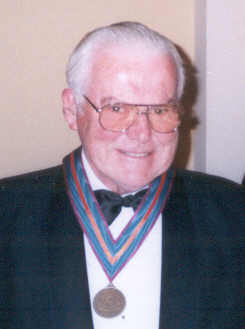 Kevin Ryan commenced collecting stamps as a schoolboy. While working in Thailand in the 1960s he developed a keen interest in that country’s philately.
Kevin Ryan commenced collecting stamps as a schoolboy. While working in Thailand in the 1960s he developed a keen interest in that country’s philately.
He joined the Launceston Philatelic Society in 1967, shortly after moving to Tasmania. In 1972, he joined the Tasmanian Philatelic Society and the Glenorchy Stamp Club in 1973, over the intervening years he has served on the committees of both groups in many capacities. He is a Life member of both the latter groups as well as the Patron of the Tasmanian Philatelic Society.
Kevin’s quest for knowledge resulted in the publication of Siam Lithographed Surcharges 1949-1956 which was awarded a silver bronze medal at Bangkok in 1993. He also contributed articles to the journals Thai Philately and Thai Times.
In the period from 1980 to 1993 he exhibited his Asian collections at various State and national exhibitions in Australia, New Zealand and Bangkok, achieving silver and vermeil awards.
He helped form the Philatelic Association of Tasmania and was later served as Secretary, then President of the Tasmanian Stamp Council and held various positions on the Purves Foundation.
Kevin was a State and national level judge, as well as a commissioner to both national and international exhibitions.
[ Source: APF News, October 1997 ]
Postscript
(by Malcolm Groom, MAP)
Kevin Ryan passed away suddenly in Launceston in July and was buried after a service in St John’s Church at Glenorchy on 9th August 2004. With his passing we lost a committed philatelist and a great mentor to exhibitors and organised philately, particularly in Tasmania.
Kevin was the first Tasmanian delegate to the Australian Stamp Promotion Council (later the APF) and one of the founding members of NAPE. He encouraged many members of NAPE. He encouraged many others into organised philately and exhibiting nationally and internationally. He had a great philosophy that exhibiting was a personal challenge and something to be enjoyed first and foremost and was always available with constructive advice and encouragement.
He began collecting in 1957 with Australian First Day Covers but during time in Thailand from 1963 to 1967 as an Engineer he developed an abiding interest in Thai philately culminating in exhibiting Siam Lithographed surcharges to Vermeil level in Bangkok 93 and publishing a book on his research entitled Siam Lithographed Surcharges, 1914-1916.
Kevin was a member of all the Tasmanian philatelic societies and was Patron of the Tasmanian Philatelic Society for ten years before his death. He served on the Committee in many capacities and was a founding member of the Tasmanian Stamp Council and its forerunner. He was a delegate to the Stamp Promotion Council. For his work in Australian philately he was made a Member of the Australian Philatelic Order in 1997.
He researched many aspects of Thai philately and was a member of and regular contributor to the journals of the Thailand Philatelic Societies of Great Britain and Thailand and had many friends in those societies.
Kevin was also a National judge and commissioner and deeply involved in all the exhibitions in Tasmania. He was also an unstinting worker at all the National exhibitions from 1967 until 1999.
His encouragement, knowledge and friendship will be sadly missed in Australian philately.
[(Source: The Asia Pacific Exhibitor, No. 62, November 2004 )
David Collyer
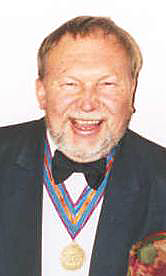 David John Collyer has been actively involved in Australian and New South Wales philately for more than 25 years.
David John Collyer has been actively involved in Australian and New South Wales philately for more than 25 years.
During this period he has served on the New South Wales Stamp Council since its inception and has similarly been a Project Officer for the Australian Philatelic Federation since its formation. Currently he is also the Australian Philatelic Federation, National Philatelic Research Officer and, in this capacity, has provided assistance and information to all levels throughout Australia. He has also served long terms as librarian of the Philatelic Association of New South Wales (PHILAS) and, more recently, been their research officer. In recognition of his services he was awarded the New South Wales Certificate of Merit in 1984 and the Meritorious Service Medal in 1987.
David’s collecting interests cover a wide area including commercial airmails 1929-1942, Australian Printed to Private Order (PTPO) envelopes, and Armed Forces postal history. He has exhibited at many national and state level exhibitions and acted as a judge for both Literature and other classes.
He has also provided invaluable expertise on the organisation and management of philatelic exhibitions in his role as a member of the New South Wales State Exhibition Secretariat.
Another of David’s major contributions to philately has been his promotion of philatelic literature. His Airgraphs and Australia and research articles relating to his subject have been awarded medals both nationally and internationally. He has also co-authored several monographs with Richard Peck and edited and published the Australian Forces Mail Research Group Newsletter. He has assisted many philatelists, from beginners to specialists, in research, and has always been willing to share his expertise. His contribution to the Australian Philatelic Federation as Project Officer (both Archives Officer and Publications Officer, concurrently) has been significant.
( Source: APF News, October 1996 )
David Ingle (Dingle) Smith, MAP
 David, more commonly known as Dingle Smith has been a driving force in promoting philately in the Australian Capital Territory for many years. He has been a member of the Philatelic Society of Canberra for more than 20 years and a member of the Australian Capital Territory Philatelic Council since its inception in 1980. He has held a number of positions in both organisations including terms as President.
David, more commonly known as Dingle Smith has been a driving force in promoting philately in the Australian Capital Territory for many years. He has been a member of the Philatelic Society of Canberra for more than 20 years and a member of the Australian Capital Territory Philatelic Council since its inception in 1980. He has held a number of positions in both organisations including terms as President.
He has also been a member of the organising committee of all National Philatelic Conventions in Canberra since 1982, holding various positions including Chairman, Operations Manager and Dealer Liaison.
He is a national judge in Postal Stationery, Aerophilately, Literature, and Revenues and Cinderellas. Dingle has formed a number of distinguished collections including Jamaica (traditional, postal history and postal stationery), Australian States’ Revenues and New South Wales Postal Stationery all of which have been exhibited nationally and internationally. He also has a number of other collections which have been displayed to philatelic societies in Australia, South Africa and Canada.
Dingle has been a prolific writer on philatelic subjects and has published over 50 articles in a number of journals. Whilst of a wide variety, the concentration of these articles has been revenues and postal stationery. He has been a constant promoter of revenues and has written the seminal work on judging Australian Revenue Exhibits. He is also joint author of The Specimens of New South Wales Postal Stationery, and is the current editor of the journal, Capital Philately. Dingle has been very prominent in the ACT in promoting and publicising philately.
He was an inaugural member of the ACT Youth Philately Clubs Organising Committee and acted as ACT Philatelic Council youth coordinator for several years. He organised and ran courses on stamp collecting for the ACT Stamp Promotion Council and the Philatelic Society of Canberra, been a teacher at advanced collector and exhibitor courses run by these organisations and been a member of the training panel for State level judges courses since 1984. He has also provided radio publicity for philately in the ACT region for both the ABC and commercial stations.
[ Source: APF News, October 1996 ]
Note: Dingle was subsequently made a Fellow of the Australian Philatelic Order in 2009.
Nita Wilson, MAP
Nita Wilson’s contribution to New South Wales philately has been outstanding. She was a member of the original PHILAS executive, the first organised Philatelic Association in New South Wales and has served as its Treasurer since 1976. Her astute handling of financial administration of the Association since that time has placed organised philately in New South Wales on a firm financial basis. She has assisted PHILAS auctions with financial administration since their inception in 1975 and was a very successful Exhibition Treasurer for both Sydpex ’80 and Sydpex ’88.
Apart from her association with PHILAS, Nita has had a long standing association with the St George Philatelic Society and the Royal Sydney Philatelic Club serving on the executive of both clubs in a number of positions. She is also a Fellow of the Royal Philatelic Society of London.
In the field of collecting Nita is best known for her collections of Australian aerogrammes and Australian coil stamps. She has exhibited at a number of international and national exhibitions, and was an early member of the Judges Register established on behalf of the Australian Philatelic Federation with expertise in traditional philately at a national level. She has also assisted in judging at several State level exhibitions.
Nita has written a manuscript on Australian aerogrammes, supplied listings of aerogrammes for the Australian Stamp Catalogue, and has written a paper on her collection of Australian coil stamps. She has also compiled a handbook/checklist on financial practice for National Philatelic exhibitions derived from her experience at Sydpex ’80 and Sydpex ’88.
Nita has also been involved in promoting youth philately by organising a youth stamp club for the St George Philatelic Society and by assisting local Guides and Brownies with their stamp collecting badge tests.
[ Source: APF News, October 1996 ]
Ross Duberal, FAP
Ross Duberal is best known for his traditional exhibit of Fiji, but he also has exhibits of Fiji postal stationery, Aitutaki, Honduras and Western Australian postal history. He has shown these exhibits widely at State, National and world exhibitions in the period 1967 to 1994, achieving many awards.
Ross has served as an Executive member on most Western Australian State level exhibitions since 1979 and on several occasions been either Jury Chairman or Committee Chairperson. He has judged at State and National Exhibitions as well as the World exhibitions at Ausipex ’84 and Grenada ’92.
Ross was co-author of Fiji: the stamps and postal history, 1870-1875 published in 1970. He also wrote two chapters and prepared all the illustrations for Western Australia – the stamps and postal history published by the Western Australia Study Group in 1979. Additionally he has written many articles for world-wide journals and was editor of Black Swan from 1975 to 1980.
Ross is a member of the Philatelic Society of Western Australia and in 1974 was co-founder of the Western Australia Study Group, on which he has served in various Executive positions. He has also been President of the Western Australia Stamp Promotion Council and the Western Australian Philatelic Association and is currently a Committee member of the State Philatelic Council.
With the formation of the National Association of Philatelic Exhibitors, Ross w as elected Secretary / Treasurer in 1991/92 and editor of the Association journal form 1988 to 1992.
Ross has been extensively involved in the fields of education and training at both junior and adult levels. He has also undertaken several radio and TV interviews to promote the hobby and been guest writer for a short period on “Weekend News”.
In 1987 he was awarded the Hasluck Medal for outstanding service to Western Australian philately.
Brian Farmer
Brian Farmer has been a member of the Philatelic Society of South Australia for more than 25 years, serving in a number of executive positions, including President and Treasurer. He is also a member and contributor to the South Australian Study Group, the China Study Group and the Australian Airmail Society.
In 1976, Brian was elected President of the South Australian Philatelic Association, which was formed by delegates from all affiliated Philatelic Societies and Clubs, a position he held until 1978, when be became Chairman of the South Australian Stamp Promotion Council (later the South Australian Philatelic Council), a position he held until 1990, when the Council amalgamated with the the South Australian Philatelic Association.
He was also chairman of the the committee formed to establish a home for philately in South Australia, which was achieved with the purchase of a property now called SAPHIL House. In 1993 Brian was awarded the Briskham Medal in acknowledgement of his services to South Australian philately.
Brian has also been prominent in services to the Australian Philatelic Federation for many years holding the executive positions of President, Vice-President and Treasurer.
Brian’s collecting interests are in the fields of South Australian “Departmentals” and astrophilately, he also has a collection of China. Brian has been very committed to conducting successful philatelic exhibitions in South Australia. He was President of the Organising Committee for Stampex ’86, the first FIAP Asian International Exhibition held in Australia. He was also President of Stampex ’91 and Treasurer of Aeropex ’88 and Aeropex ’94.
Brian is a National Judge and makes himself available to judge at philatelic exhibitions from Club to National level.
[(Source: APF News July 1995 )
Eric Hurrell, MAP
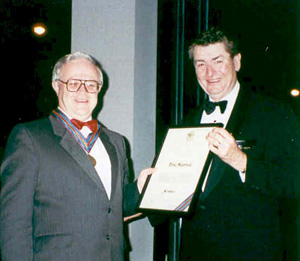 Eric Hurrell has been prominent in South Australian philatelic organisations for many years. He was Secretary of the South Australian Philatelic Association from its formation in 1977 until 1984, when he was elected President. A position he held until the Association amalgamated with the South Australian Philatelic Council in 1990, at which time he was elected President of the new Philatelic Council, holding the position until 1992, when he retired.
Eric Hurrell has been prominent in South Australian philatelic organisations for many years. He was Secretary of the South Australian Philatelic Association from its formation in 1977 until 1984, when he was elected President. A position he held until the Association amalgamated with the South Australian Philatelic Council in 1990, at which time he was elected President of the new Philatelic Council, holding the position until 1992, when he retired.
The major achievements of the South Australian Philatelic Association were to conduct annual Congresses, which included a statewide philatelic competition, the arranging of judge training courses and preparations for the Inter-Asian philatelic Exhibition, Stampex ’86. Eric also supported the activities of the South Australian Stamp Promotion Council (later the South Australian Philatelic Council) during this period, working closely with its President, Brian Farmer, to conduct stamp fairs, assist with the Maximum Card project and to distribute educational material to young people.
He was also Secretary of the committee formed to purchase the property now known as SAPHIL House. At the local level Eric has been a member of the ETSA (Electricity Trust of South Australia) Stamp Club since 1972, serving in many executive positions. In 1986, Eric was awarded the Briskham Medal for his services to South Australian philately.
Nationally Eric held the position of Secretary of the Australian Philatelic Federation during 1991 and 1992. He was Secretary of the organising committees of State, National and International philatelic exhibitions such as Stampex ’86, ’88 and ’91 and Aeropex ’88 and ’94.
He has also been prominent in encouraging competitions at the local level to provide exhibiting experience for new exhibitors as well as judging experience for new judges. Eric is an accredited State level judge in the Youth and Thematic classes.
Eric’s main collecting interest is Australia which he has exhibited and also displayed at many societies. He also promotes philately through radio interviews and talks.
Pictured top right: Eric Hurrell (left) receives his MAP award from Maurice Williams AM, Chairman of Australia Post.
( Source: APF News July 1995 )
Eric Hurrell has been prominent in South Australian philatelic organisations for many years. He was Secretary of the South Australian Philatelic Association from its formation in 1977 until 1984, when he was elected President. A position he held until the Association amalgamated with the South Australian Philatelic Council in 1990, at which time he was elected President of the new Philatelic Council, holding the position until 1992, when he retired.
The major achievements of the South Australian Philatelic Association were to conduct annual Congresses, which included a statewide philatelic competition, the arranging of judge training courses and preparations for the Inter-Asian philatelic Exhibition, Stampex ’86. Eric also supported the activities of the South Australian Stamp Promotion Council (later the South Australian Philatelic Council) during this period, working closely with its President, Brian Farmer, to conduct stamp fairs, assist with the Maximum Card project and to distribute educational material to young people.
He was also Secretary of the committee formed to purchase the property now known as SAPHIL House. At the local level Eric has been a member of the ETSA (Electricity Trust of South Australia) Stamp Club since 1972, serving in many executive positions. In 1986, Eric was awarded the Briskham Medal for his services to South Australian philately.
Nationally Eric held the position of Secretary of the Australian Philatelic Federation during 1991 and 1992. He was Secretary of the organising committees of State, National and International philatelic exhibitions such as Stampex ’86, ’88 and ’91 and Aeropex ’88 and ’94.
He has also been prominent in encouraging competitions at the local level to provide exhibiting experience for new exhibitors as well as judging experience for new judges. Eric is an accredited State level judge in the Youth and Thematic classes.
Eric’s main collecting interest is Australia which he has exhibited and also displayed at many societies. He also promotes philately through radio interviews and talks.
Pictured top right: Eric Hurrell (left) receives his MAP award from Maurice Williams AM, Chairman of Australia Post.
[ Source: APF News July 1995 ]
Richard Peck, FRPS,L MAP
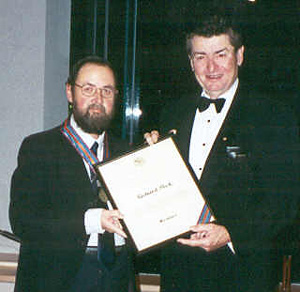 Richard Peck is well known for his support of the Australian Commonwealth Collectors Club of New South Wales, serving on its committee since 1974, with terms as President, Secretary and Treasurer.
Richard Peck is well known for his support of the Australian Commonwealth Collectors Club of New South Wales, serving on its committee since 1974, with terms as President, Secretary and Treasurer.
He was also a member of the Philatelic Association of New South Wales (PHILAS) executive from 1978 to 1984. During that period he was editor of the Association journal and Convenor of the Fund Raising Committee. In the mid 1980s he was a Philas delegate to the New South Wales Stamp Council.
For a five year period in the 1980s, he was a member of Australia Post’s Stamp Advisory Committee.
Richard was Secretary of the National Philatelic Exhibitions, Sydpex ’80 and ’88 and acted as Exhibition Co-ordinator for Georgepex ’87 and Norpex ’87. He has exhibited frequently at national exhibitions and is also a nationally qualified judge in the philatelic literature class.
In 1982, Richard led the Australian Philatelic Exhibition to China, an activity conducted in co-operation with the Department of Foreign Affairs.
Richard’s collection interests are wide, but he is best known for his collection of Australian meter impressions. He has also developed collections of modern Australia emphasising non traditional areas such as Framas and postal charges labels. His other collecting interest is the philately and postal history of Tristan da Cunha, a subject on which he has written a two volume encyclopaedic work. He has published very widely on a variety of topics including specialist catalogues on Australian meters, Australian postal labels, and works on Western Australian postal stationery and the maritime mails of New South Wales. He has edited several journals, Sydney Views, Frama Imprint and Australian Meter News.
Richard Peck has been the Curator of Philately at the Museum of Applied Arts and Sciences for several years. He is a Fellow of the Royal Philatelic Society, London.
(Source: APF News July 1995 )
Alan Salisbury, MAP (1917 – 2004)
Alan Salisbury has been a stamp collector for almost 80 years, forming important collections in the fields of postal history, postal stationery, traditional and cinderella classes. He has collections of many countries not widely sought in Australia, such as Tibet, Mongolia, Taiwan and Bulgaria, as well as collections on the Australian Commonwealth, New South Wales and Pacific region.
Alan has been a member of the Philatelic Society of Canberra for 36 years, holding many positions on the executive, including President, during that time. He also served on the ACT Philatelic Council and was a member of the Organising Committee for several State level exhibitions as well as the national exhibition Sydpex ’80. He has judged at numerous State and National exhibitions and at the FIP World exhibition, Ausipex ’84.
Alan is best known for the monthly column Commonwealth Corner he wrote for Stamp News over 14 years. He was also foundation editor of Capital Philately, which he edited for more than five years, writing many articles for that journal and for others such as Stamp Talk, Australian Commonwealth Collectors Club and Stamp News. His research skills were recognised in 1975 by the Australian Commonwealth Collectors Club, which awarded him their Research Medal.
For the past 30 years, Alan has been at the forefront of philatelic teaching and training in the ACT.
He has run, or been associated with, the successful biennial School of Philately, has conducted adult appreciation courses through service clubs in the region, and has visited local schools to encourage children to take up the hobby.
[ Source: APF News July 1995 ]
Norman Sheppard, MAP
Norman Sheppard is well known for his association with the Australian Commonwealth Collectors Club of New South Wales, having been the Editor of its Bulletin since its inception in 1962, and a member of its Committee since the early 1960’s, including a term as President. He edited the NSW Philatelist and served on the executive of the Philatelic Society of New South Wales, including 17 years as President. He is currently an executive member of the Philatelic Association of New South Wales (Philas), serving as President from 1973 to 1976.
Norman’s main collecting interest is the Australian Commonwealth, especially the King George V side face issues. He also collects Russia and has an extensive collection of World War I Russian censorship markings as well as comprehensive collections from imperial Russia and the earliest years of the Soviet Union. He has published extensively and was part of the team which recorded in detail the die for the Kangaroo and Map stamp. In collaboration with Don Cox of Newcastle, he recorded the “AR” (registration, Advice of Receipt) system in Australia. He has been associated with the Philatelic Society of New South Wales works on the Papuan Lakatoi series and, since 1984, has been convenor of the Philas Publications and Research Committee, which co-ordinated the production and publication of the Postal History of NSW 1788-1901.
He was a member of the exhibition committees for Sydpex ’80 and ’88, and has been a national judge since 1983, where his expertise lies in the field of philatelic literature. At State level he has been Chairman of the Jury at several philatelic exhibitions.
(Source: APF News July 1995 )
Russell Stern, MAP
Russell Stern has had a long association with the Philatelic Society of New South Wales, serving as Secretary for 21 years and also a period as President. He was instrumental in the formation of the Philatelic Association of New South Wales and was also a foundation member of the New South Wales Stamp Council, serving on both executives from their inception. In the mid 1970s he organised the search for a suitable home for philately in Sydney, which eventually resulted in the purchase of the property which became Philas House.
From 1977 to 1981 Russell was secretary of the Australian Philatelic Federation. It was during this period that a financial base for national philately was organised and a programme of national exhibitions developed.
Russell’s main exhibiting area is Australian Forces mail, he also has traditional collections of Bahamas and Bermuda. He has exhibited at State, National and International Exhibitions and was a judge at Sydpex ’88. He also conducted a number of courses for exhibitors before Sydpex ’88 aimed at improving the standard of entries.
From 1991, Russell has been editor of the NSW Philatelist, during this period he has overseen the implementation of computerised publishing.
[ Source: APF News July 1995 ]
Research
(Introduced 1997)
Dave Elsmore Australian Research Award

The APF preamble to the Research Awards contains the following phases: that the recipients should provide `particular value to the Australian Philatelic Community where the research and work record the work for the benefit of other collectors’ and `…a special talent in conducting research and making it available to other collectors successfully’. It is clear that Dave Elsmore has and will continue to fulfill those aims.
He is the pioneer in Australia of the use of electronic media for which he is internationally known as well as the outstanding advocate, exhibitor, and publisher of Australian Revenues and Railway stamps of all the Australian States together with a wide range of fields of philately such as Queensland postage stamps, Revenue Perfins and Australian Cinderellas.
His On-line catalogues of Australian Revenues, Railway Parcel stamps, Revenue and Railway Perfins, Cinderellas and related material are the standard references and a source of reference for collectors and dealers all over the world. He has published extensively including journal articles in world wide recognized philatelic journals as well as publishing many books. He has contributed articles based on his research and ran a 10 year ‘Revenue Review’ column in Stamp News. All available on ozrevenues.com for free.
He has over 20 exhibits attaining Gold Medals or better, including Literature Gold. One exhibit in particular his Queensland Revenues 1866-1930 is an APF Classic Exhibit for which he received the first FIP Large Gold Medal for an Australian Revenue Exhibit; this exhibit also received Felicitations from the Jury for exceptional research.
He is also responsible for writing the current (at the time of writing) Revenue SREV’s available on the FIP Revenue Commission website. He is also known for mentoring several International and National Revenue Judges.
In addition to his research, he is an active member of related Societies a life member of the Logan City Philatelic Society Inc. In which he started nearly 50 years ago running as President for 10 years. He is one of the most active members of the Perfin Club of New Zealand and Australia he built perfins.com.au again free for all and for over 30 years the Exchange Superintendent of the Cinderella & Revenue Stamp Club of Australasia, where some years ago he successfully introduced internet sales associated with exchange books. His outstanding service, research and promoting Revenue, Railway and Cinderella philately are recommended for recognition by the APF.
John Hardinge

John Hardinge has been researching and writing on Tasmanian Postal History for over 35 years and now has 8 significant works in print as well as many journal articles. His publications are the acknowledged reference works on Tasmanian postmarks, Post Offices and barred numerals.
His books are held in many philatelic libraries within Australia and overseas and are the standard references for dealers, collectors and postal historians on all aspects of Tasmanian Postmarks including rarity ratings.
His publications have sold many hundreds of copies and his recent major work, published in 2018 by the Tasmanian Philatelic Society ‘The Post Offices and their Datestamps” sold out from a print run of 250 copies within 6 months, which is a good indication of the importance of his work.
John became interested in Tasmanian postal history at an early age and by the early 1990’s was actively recording and researching both Tasmanian postmarks, Post Office openings and closures and barred numerals. He researched local archival sources, earlier work by Campbell, Purves and others and began working cooperatively with other Tasmanian postal Historians recording as many examples of postal markings as possible.
Over time, John built a large database of Tasmanian Post Office openings and closings and circular datestamps, recording types, early and late dates and deducing rarity ratings. He co-authored an early publication on Tasmanian Post Offices in 1991 and in 1996 published his own revised version. By then he had written the then acknowledged reference work on Tasmanian postmarks in 1993 and 94 – “Tasmanian Hand-held Cancellations 1913-88 – parts 1 & 2” (Magpie Publications)
He has developed and extended the Tasmanian postmark taxonomy – the circular datestamp classification system used by all Tasmanian postmark collectors.
In 2009 and 2010, John published the definitive listing and rarity ratings for Tasmanian Barred numerals in the TPS Journal, The Courier. This reference is still used by dealers and serious collectors of Tasmanian Barred numerals
Following this, he published a series of important articles on the postal history of Tasmanian datestamps in The Courier. In 2014, he published the “Guide to Circular Datestamps on Tasmanian Pictorial Issues” which has sold over 300 copies. In 2018, his most comprehensive work to date, “The Post Offices and their Datetamps “ was published in a high quality hardback edition of 250. This very quickly sold out. It documents the Tasmanian Postmark Classification system, the development of Tasmanian Postmarks in great details and lists every know postmark and important details of each, including rarity ratings
A concise version of this book was published in early 2020.
John would be the first to admit he has used and expanded on all research that came before him but his strengths are that apart from his own extensive research over a period of 35 years, he has assiduously recorded and published observations from many other collectors. Thanks to his efforts since the early 1990s, Tasmania has arguably the best record of its postmarks and numerals of any State.
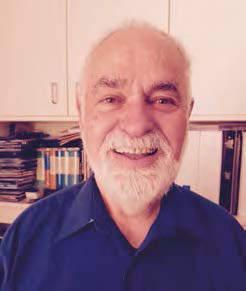
Ed Wolf is an active philatelist who specialises in the field of Aerophilately. His main collecting areas are the development of airmails within Australia and the development of airmail services to Australia from Europe in the West and America in the East. Ed has supported journals with a wide range of topics on Aerophilately. He has also written significant monographs which have broadened our knowledge of Aerophilately
Ed’s work “The QANTAS Coronation day airmail flights June 1953-the untold story” extended previously work done at the time of the promotion. It showed that there was not just one flight connected with the Coronation Day airmail in June 1953 but a series. This work was based on archival research in London on the use of contemporary airline timetables to when flights took place which included airlines other than Qanta
In the 21st Century Ed looked at the development of flights that laid the foundations for regular air services between England and Australia. This commenced with the publication in 2012 of ‘The flight of the Old Carthusian’, the story of the first flight from England to India, the first half of the route to Australia. Ed used documents from the Public Record Office at Kew to develop a new understanding of the flight of the ‘Old Carthusian’ and its subsequent history.
A further outcome of the flight of the ‘Old Carthusian’ was the story of what happened to the mail from an Australian Light Horse Wireless unit at Baghdad in early 1919 and how it was carried by the ‘Old Carthusian’ and subsequently got to Australia on the Ross Smith Vickers Vimy flight. Ed used the digitalised WWI nominal roll records from the Australian War Memorial to match known Baghdad mail to family members in Australia. He also established the connection between the sergeants on the ‘Old Carthusian’ and the Ross Smith Vimy.
Ed’s most recent work has been connected with the surveys that laid the way for the participants in the 1919 England-Australia air race between Calcutta and Darwin and within Australia. Material for the Borton-Ross Smith survey from Calcutta to Timor was based on records from the Public Record Office at Kew. Material for the Lloyd land survey from Sydney to Darwin was based on material from digitalised Newspaper recorded from the National Library of Austra
Ed Wolf has been an active researcher and collector of Australian Aerophilately for many years. He is a collector of Aerophilately, has written journal articles and has authored a number of books. His work on the Ross Smith flight and its predecessors has answered a number of little known areas. Ed’s research has progressed Australian Aerophilately in recent years.
Bert Wajer
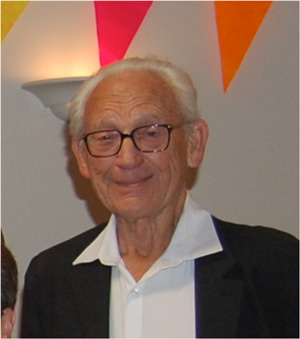
Bert was one of the founding members of the former Australian Commonwealth Group of the Philatelic Society of South Australia and a major contributor to the Group’s Journal Stamp Talk over many years.
His main area of research has been in the King George V Head issues in all denominations and he has researched and plated the 4½d and 1/4 d values and privately published monographs. Other work has involved research on the 1d Die 3 and again he privately published his research, and also his co-research on the 2d Die 1. In conjunction with Mr. M. Hill of Melbourne, Bert researched the ½d value.
He was also acknowledged in the 1988 edition of the Australian Commonwealth Specialists Catalogue for his work on the new format and extensive revisions to the King George V Head issues.
He has been actively involved with Gordon Monk and the late Paul Kaigg in the research work on the King George V One Penny issues, in particular the One Penny Die II.
Further to the work above Bert has also researched and plated the 4½d surcharge value.
His research and tireless effort over many years and his willingness to share the wealth of knowledge and research deserve recognition and the Philatelic Society of South Australia is pleased to nominate him for the Australian Philatelic Order Research Award.
David Collyer
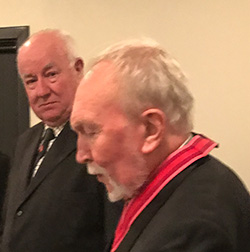
David Collyer (John Moore, APF President, back)
Since receiving his Member of Australian Philately award in 1996, David John Collyer has spent the last 24 years continuing his tireless work in promoting and progressing philately in Australia generally and in New South Wales particularly. His name in that State is a byword for knowledge and willing assistance.
David‘s major contributions to philately has been his promotion of philatelic literature, including the publication of a number of monographs he has written. He has assisted many philatelists, from beginners to specialists, in research, and has always been willing to share his expertise. His latest contribution to the publication of philatelic literature was a joint effort with two other authors on the QANTAS Coronation Day flights, June 1953.
In addition to this, he is the Research Officer for the Australian Philatelic Federation (APF), is the Publications Assistance Officer and is their Archivist. Their archives are held at Philas House. He is also the Coordinator of the State Council Forum, held each year in conjunction with the APF Annual General Meeting. This Forum includes the Sunday Soviet, which David has chaired since its inception in 1996. He is the APF Convenor for Polar Philately and is the FIP Commission Delegate for Traditional philately.
He is a member of the Philas Library Inc. Committee, being their current Research and Publications Officer. Previously, he served long terms as their Librarian. In his current position, he provides assistance and information to all levels of philately throughout Australia. He has an encyclopaedic memory and can tell almost immediately whether the Library carries any information on any particular subject, and can find that information with little delay. He also introduced the system whereby the Library provides background material for Judges at Exhibitions, to assist them with their judging, should the Exhibition Organising Committee request it.
David‘s collecting interests cover a wide area including commercial airmails, Australian Printed to Private Order (PTPO) envelopes, and Armed Forces postal history. He has exhibited at many National and State Level Exhibitions and has judged Literature and other Classes.
Bill Fiora
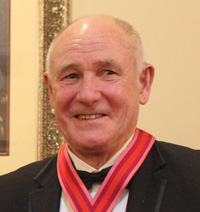
There are a number of long established awards for philatelic research and writing within most State and specialist Societies which are, however,restricted to members of those Societies.
The Australian Philatelic Order eminently recognizes philatelists who have rendered distinguished service to Australian philately.
Philatelic research and study represents only thirty per cent of the assessment in deciding the merit of these awards.
A significant number of likely recipients of a Research award are people, both professional and collector philatelists who have devoted much of their philatelic life to their writing and study limiting the time they can contribute to the other aspects of philatelic life in Australia. There is a particular value to the Australian philatelic community in those people who research and record their work for the benefit of other collectors. There is also a special talent in conducting this research and in making it available to other collectors successfully.
Bill is Author of numerous articles for publication in the Australian Commonwealth Collectors Club (ACCC) of NSW Bulletin and the British Society of Australian Philatelists Bulletin (BSAP) since 2009 covering all new discoveries from personal research of the Australian KGV 11/2d stamps.
He also assist Moderators on Stampboards with queries from collectors for the KGV 11/2d stamp.
The following is a list of some of his publications;
Author of Aust KGV 11/2d Die I stamp, Flaw Location Guide
Sole Author – in excess of 5000 drawings, all drawn to scale from the stamps themselves.
3 years of research.
Part 1 (Electros 1-12) 1st Edition published in November 2011 – 2nd Edition, December 2013Part 2 (Electros 13-29)1st Edition published in November 2011 -2nd Edition, December 2013 Author of Aust KGV 11/2d Die II stamp, Flaw Location Guide Sole Author –in excess of 3000 drawings, all drawn to scale from the stamps themselves. Research and Publication of complete update of any previously published material. 2 years of research. [2016] Co-contributor to the revision of the Aust KGV 11/2d Die1 stamp, published by the Australian Collectors Club of NSW.
Complete update of research to date for these books.
Contributors were Richard Guy (Convenor), Jim Biggs. Dr John Chadwick (dec), Bill Fiora, Don Landers, Brian Parsons (dec), Harry Robinson (dec), Norm Sheppard (dec), Lance Skinner Part 1 (Electros 1-14 published in 2005 —
Part 2 (electros 15-29) published in 2009 Co-Author with Laurie Costantin of a Plating Guide for the KGV 11/2d Red Die II Small Multiple Watermark P13.5×12.5 Booklet Stamp.
Identified previously unrecorded flaws for 40 booklet panes from 2 steel plates. This was previously recorded in the ACSC as having only 1 steel plate.
1stEdition published April 2013 -2ndEdition published June 2016
Co-Author with Laurie Costantin of a Plating Guide for the 2d KGV Die III Small Multiple Watermark and C of A Watermarked Stamps.
Identified previously unrecorded flaws for 40 booklet panes from 2 steel plates. [2013]
Congratulation to Bill Fiora for his dedication to Australian Philatelic Research.
Richard Gurevitch
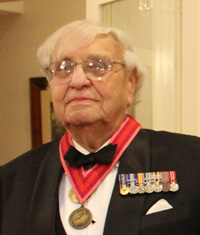 Richard Gurevitch is a doyen of Hong Kong philately and has undertaken much research on early Hong Kong stamps, together with their usage on cover. Richard has re-searched and written three books on the Queen Victoria stamps of Hong Kong. An early booked called Hong Kong Stamps of the Queen VictoriaPeriod –« A Collector‟s Notebook‟ in 1993, then a two-volume book titled Hong Kong: Postal Adhesives Volumes 1 & 2 in 2001, and most recently Hong
Richard Gurevitch is a doyen of Hong Kong philately and has undertaken much research on early Hong Kong stamps, together with their usage on cover. Richard has re-searched and written three books on the Queen Victoria stamps of Hong Kong. An early booked called Hong Kong Stamps of the Queen VictoriaPeriod –« A Collector‟s Notebook‟ in 1993, then a two-volume book titled Hong Kong: Postal Adhesives Volumes 1 & 2 in 2001, and most recently Hong
Kong: Franked Covers of the Queen Victoria Period. In addition, Richardhas an update on the 2001 work almost ready to print. Richard has also produced 24 articles on Hong Kong stamps, all based on his own research
of the stamps. Much of the research is new to philately. In re-searching and writing his two-volume work on the stamps, Richard went back in the
literature to original sources and corrected some errors that had been perpetuated for many decades. He has also exhibited his stamps (and research). In addition, Richard has a strong interest in the smaller South American countries, which he has exhibited,including new research and has produced articles on Costa Rica and Haiti.
Richard has also been asked to give opinions on the genuineness of early Hong Kong stamps and varieties. This is high praise of his research and knowledge of the area.
He is a worthy recipient of an APR.
HUGH FREEMAN APR
Hugh Freeman‟s interest in numeral cancellations of the Australian Colonies has resulted in two seminal works on this type of cancel as used in Victoria and New South Wales; the colonies until Federation which had the largest number of Post Offices.
Victoria and New South Wales each had over 2000 Post Offices in colonial times that used numeral cancels. Many of these Post Offices existed for only a short period of time and examples are of considerable rarity.
Within the term ‟numeral cancel‟ both Victoria and New South Wales used a range of different types of design each of which is identified in Hugh‟s publications.
The data for each Post Office recorded includes the operating dates of the office and the type(s) of cancel used. To assist other collectors of this field the entry for each office in-cludes a “rarity rating‟ to give an indication between common and extreme rarity.
Strikes for most Post Offices are illustrated, allowing the collector to differentiate between partial strikes from full strikes.
Within Philately Hugh Freeman worked as a collector and a member of the trade. This crossover allowed him to develop a wide ranging network of people interested in post mark collecting.
Hugh Freeman has been an enthusiastic supporter of the hobby of philately. A significant area for that support has been the publication of separate monographs on the numeral cancellations on the post offices of the Colonies of Victoria and New South Wales. Hugh has been a valued and long term supporter of Australian philately and the research of Australian philately.
Gordon Monk APR
 Gordon Monk’s passion has been the study of Australia’s George V Penny Stamps – not just the red stamps issued during the years of the First World War, but all the issues through to the late 1930s.
Gordon Monk’s passion has been the study of Australia’s George V Penny Stamps – not just the red stamps issued during the years of the First World War, but all the issues through to the late 1930s.
One may wonder what can possibly be left to learn about Australia’s most studied and probably most important stamp issues but Gordon’s furtherance of the knowledge about these stamps has been invaluable. With an exhibiting pedigree that extends back to the late 1980s, Gordon has continually strived to improve and succeed in this field. Whilst the medals awarded to his exhibits may be considered reward enough, for Gordon it has also been a catalyst to share his findings with the collecting community through articles appearing in the journals of the societies specialising in Australian philately. These include the Bulletin of the British Society of Australian Philately, “Stamp Talk” the Journal of the Philatelic Society of South Australia, and the Bulletin of the Australian Commonwealth Collectors Club of New South Wales.In 1994 Gordon self-published “A Collectors’ List for the Surface Printed KGV1d Sideface Issues.” Prior to this in 1992, Gordon published the first edition of “The Surface Printed KGV 1d Sideface Issue Variety Catalogue”. Two further editions of this work have since been published each extending the knowledge of these issues and a testament to Gordon’s ongoing research.
Gordon’s work has previously been recognised by no less than three philatelic bodies –
2002 – British Society for Australian Philately President’s Cup
2004 – Australian Commonwealth Collectors Club of New South Wales Research Medal
2006 – Philatelic Society of South Australia – Krichauff Award
It did not stop there and in the eleven years since, the story has been continually added to – a remarkable achievement for a series of stamps that have been intensively studied for a century.
In recent times Gordon has also taken an interest in the perfins applied to postage, parcel and duty stamps by companies in South Australia and is continually adding to the already fine works in this field.
The APF has great pleasure in awarding Gordon Monk the Australian Philatelic Research Award.
Awaiting citation
Brian Peace- Research
Brian’s work is important because he was one of the early researchers working with Australia to link material with legislation. He has also made extensive use of archival and newspaper sources.
 Being based in the United Kingdom and researching an Australian topic area is inherently difficult. Brian was able to make the most of resources local to him but also travelled to Australia to collect additional information.
Being based in the United Kingdom and researching an Australian topic area is inherently difficult. Brian was able to make the most of resources local to him but also travelled to Australia to collect additional information.
Brian Peace has an interesting and lengthy association with Australian philately. He has made both an active and outstanding contribution to our knowledge of Australian subject matter.
He obtained the BPA Diploma in Philatelic Knowledge at 16, this being presented at London 1960, at the first International Exhibition he attended.
He joined the British Society of Australian Philately also at the age of 16 and was the editor of its Bulletin from 1966-70 and again from 1982-89. He is a Fellow of The British Society of Australian Philately and was awarded the Thomas E. Field Trophy for services to the Society and Australian Philately in 1970.
He also joined the Australian States Study Group of The Royal Philatelic Society London in 1970 and has made a range of contributions to its Newsletter concerning Australian colonial postal history. He is also a member of the Australian States Study Circle of The Royal Sydney Philatelic Club and has made similar inputs to its Journal’s issues.
His major work Australasian Wreck Mail (1997) has been awarded a National Gold Medal at Canberra (1998) and an FIP Vermeil Medal at Milan (1998) in the literature class. At the time of publication it was and still is the only comprehensive work of its type in book form. In 1999 the author won the inaugural John Gartner Medal from The Royal Philatelic Society of Victoria for the best work published in Australia
His major collection New South Wales Postal History has won two FIP Gold Medals at New Zealand 1990 and London 2000.
He has been a member of the Royal Philatelic Society London for forty years and has attained Fellowship.
His research is ongoing and he published Mail Robberies by Bushrangers in Australia 1833-1908 (2011). He spent considerable time combing newspapers and official sources in Australia in order to marshal data for this work.
His next work Supplement to Australasian Wreck Mail (2013) brings together new research and discoveries since the original publication.
Over fifty years he has formed the largest private library of Australasian philatelic literature that is now an important reference tool.
Although based in the United Kingdom, Brian Peace has had a significant impact on Australian philatelic research in the areas of Colonial postal rates and the recording of disaster mail.
Colin Tabeart- Research
Colin’s interest in philately commenced as a schoolboy but lapsed for several years during his early service 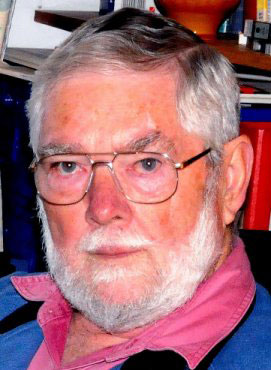 in the Royal Navy. Returning to England in 1968 for a shore job he took up “stamp collecting” again and joined his first club, the Portsmouth & District Philatelic Society, and is still a member 41 years on. Here he learnt about “ship letter” handstamps, and so began to combine his profession as seafarer with his hobby by starting to collect maritime mail.
in the Royal Navy. Returning to England in 1968 for a shore job he took up “stamp collecting” again and joined his first club, the Portsmouth & District Philatelic Society, and is still a member 41 years on. Here he learnt about “ship letter” handstamps, and so began to combine his profession as seafarer with his hobby by starting to collect maritime mail.
As his main interest moved to covers rather than the stamps, he joined the Postal History Society (UK) and was subsequently put up for membership of the Society of Postal Historians (a by invitation society for active postal historians). Because of an interest in naval mails he also joined the Forces Postal History Society and has been Editor of their Journal for the last 5 years. As Colin’s interest in steamship mails grew, he joined the US Philatelics Classics Society. For articles printed in their Journal he was awarded the Elliott Perry Cup and the Susan McDonald Award (twice). Finally after he subscribed to Sydney Views, his interests in maritime mails swung decisively to mails between the UK and Australia/New Zealand about 15 years ago.
Colin does not go in for competitive philately but prefers to share a love of the hobby in his writings and in displaying to interested Societies within reasonable driving distance. Colin has written several hundred articles that have appeared in various Journals in England, the USA and Australia.
His first published book (114pp) was in 1989, United Kingdom Letter Rates Inland and Abroad, 1657 to 1900 with a fully revised second edition (264pp) appearing in 2003. Another of his works, Robertson Revisited published in 1997 was awarded two gold medals. His next book, Admiralty Mediterranean Steam Packets 1837-1854 was published in 2002. In 2006 Colin produced a monograph (82pp) on The West India and Pacific Steam-Ship Company – The Mail Contracts 1865-1888, about which nothing had ever appeared in the philatelic press before, nor indeed has any fleet history ever been published.
However, the book that dominated his researches for about ten years finally came to fruition in 2004 as a self-published hardbound effort (430pp) titled Australia New Zealand UK Mails to 1880 which sold out in under a year. Since then, Colin has been working on research to take the story on from 1881 to 1900. At the time of his APR award, Colin had just published this 2nd volume.
In this wonderful hobby Colin has been lucky to meet and learn from so many excellent mentors and now has friends and correspondents in every continent and many countries
Brian Young – Research
Bryan Young has improved our record of knowledge of contemporary stamps since the commencement of the Decimal period. From the mid 1980’s onwards Bryan established a channel of communications with Australia Post that led to the availability of detailed information on Australian stamp issues as they were issued.
 Based in Melbourne, Bryan is a member of the Australian Commonwealth Collectors club of NSW the pre-eminent club for collecting and recording information on the stamps of the Commonwealth of Australia.
Based in Melbourne, Bryan is a member of the Australian Commonwealth Collectors club of NSW the pre-eminent club for collecting and recording information on the stamps of the Commonwealth of Australia.
He has collected the Stamps of the Commonwealth from 1927 onwards. Bryan collected by the catalogue, for the Australian Commonwealth this meant the Australian Commonwealth Specialists Catalogue. He acquired important studies from the Perc Meara collection so that this material could be available for reference.
The introduction for stamp production of offset photo-lithography made specialist collecting much more difficult. As with any change in technology researchers such as Bryan found new avenues to explore. Being based in Melbourne was an advantage because this is where Australia Post and the production centres are.
Bryan is best known for his input to the Australia Post Publication listing specialist production details. He had the ear of production personnel and of the collecting fraternity. If there were differences between the production brief and the actual issue Bryan made sure that the details were recorded for future generations of specialist collectors.
Bryan’s knowledge has also been used by the current publishers of the Australian Commonwealth Specialists Catalogue as a consultant editor on their volumes of King George VI, Queen Elizabeth II and Decimal Australia.
Bryan joins a select group who have been recognised for researching and recording Australian philatelic information, in this case keeping collectors aware of contemporary events. His efforts have assisted Australia Post by making sure that things were recorded. In turn this has assisted collectors to know what is available to collect and study.
Lance Skinner – Research
 Lance Skinner has made significant contributions in a wide range of areas to the research of the postage stamps of Australia. Lance epitomises the traditional image of the researcher of stamps, magnifier to the eye checking each example, determining its position on the sheet and observing what changes have occurred.
Lance Skinner has made significant contributions in a wide range of areas to the research of the postage stamps of Australia. Lance epitomises the traditional image of the researcher of stamps, magnifier to the eye checking each example, determining its position on the sheet and observing what changes have occurred.
Monographs
Lance has been associated with both editions of the listing of the King George V side face 1½d Die 1. In 1969 along with Julie Resch he contributed to the first publication on this subject which was coordinated from United Kingdom. At the start of the 21st Century Lance and a group of like minded philatelist rewrote the original work for the first fourteen electro’s of this issue. This work was launched at the December 2005 meeting of the Australian Commonwealth Collectors Club. The new work is significant because it includes new material found since the original publication. The format is innovative in that the text and illustration pages are side by side. This published was a team effort which shows that there is still much to research in the King George V side face issues of the Commonwealth of Australia.
Journal Articles
Lance’s research finding have been produced mainly in the Bulletin of the Australian Commonwealth Collectors Club of NSW and the Bulletin of British Society of Australian Philately. In the first 30 years of the ACCC Bulletin Lance had material published in 24 years, 76 articles. In recent years the Bulletin will have at least one major article from Lance each year. Lance enjoyed the King George V side face issues but wrote about a range of topics on the stamps of the Commonwealth of Australia.
Research areas
1959 5d Blue Queen Elizabeth
1960 8d Tiger Cat
1963 Export commemorative
1963 5d Green Queen Elizabeth
1965 5d Red Queen Elizabeth
1966 low value Decimal Definitive (1c-7c)
Lance has been the co-ordinator of the King George V Study Group of the ACCC for over 10 years. He is also the co-ordinator of the Frama Study group of the ACCC for over 10 years
He has been awarded the ACCC Research medal. In 2001 he was made a fellow of the British Society of Australian Philately for his contributions to philatelic study
Lance has collections from most philatelic periods of the Australian Commonwealth. He has a significant collection of King George VI plate number which was used in the revision of the Australian Commonwealth Specialist Catalogue
Lance has also collected postal stationery of the Commonwealth period
His most recent foray has been in the International Post issues of Australia. Lance is a strong supporter of club displays which enable him to show how material can be researched.
Dr Geoffrey Lewis – Research
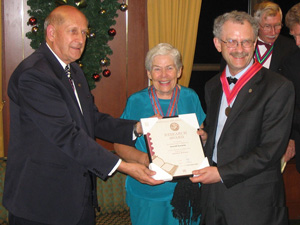 Dr. Geoffrey Lewis is an internationally acknowledged student who deals mainly with the postal history of Spain and its colonies. His Monograph and journal articles on the Spanish Philippines have an importance in regards the postal history of adjacent areas in Asia.
Dr. Geoffrey Lewis is an internationally acknowledged student who deals mainly with the postal history of Spain and its colonies. His Monograph and journal articles on the Spanish Philippines have an importance in regards the postal history of adjacent areas in Asia.
He has also written journal articles on a range of pre twentieth century postal history topics. Dr Lewis has also fostered research in the NSW Philatelist, published by the Philatelic Society of New South Wales where he as been President for over 10 years.
He has formed significant exhibits of Postal History on the Spanish period of Philippines and Cuba as well as mail through Spain. The research shown in each of these exhibits has helped them attained high awards at International level. He is one of a few international collectors who have been invited to be a member of the Spanish Academy of Philately.
Martin Walker, FRPSL – Research
 Martin Walker began collecting stamps in the late 1960s and in 1970 he joined the then new Para Hills Stamp Club. By 1972 he was a member of the Junior committee of the club; in 1986 took on the position of Treasurer; in 1988 he became President, a position he still holds today.
Martin Walker began collecting stamps in the late 1960s and in 1970 he joined the then new Para Hills Stamp Club. By 1972 he was a member of the Junior committee of the club; in 1986 took on the position of Treasurer; in 1988 he became President, a position he still holds today.
He became interested in collecting the stamps of the Australian Colonies, as he says, ‘simply because no one else wanted them’ His interest in Postal History was kindled by the discovery of some South Australian stamps with postmarks like Alice Springs S.A. and Port Darwin S.A. and the collecting of postmarks took on a whole new meaning.
In 1976 he was invited to attend a meeting called to assess the feasibility of forming a club specialising in the collecting of things other than postage stamps, but still related to the postal service. This Club was founded as the Postal Stationery and Postal History Society of Australia which produced a journal, The Posthorn and Martin held the position of editor for a period of time until work commitments precluded his further involvement.
Martin then commenced collecting details about PO’s from which he had examples of postmarks and this ultimately led to details about all post offices in South Australia and Northern Territory.
He formed the finest collection of Postal Stationery of South Australia which won Gold at exhibitions. The meticulous research carried out made this collection a monograph in its own right. Once this collection had reached a stage where it could not be improved, Martin sold it as a collection but unfortunately it was broken up before it could be recorded as such.
Martin then turned to other fields for research. At that time the study of South Australian revenue stamps was commencing so Martin took this project on and once again formed a collection of these stamps. A huge amount of personal research was required to assemble the collection and Martin’s search for the relevant information led him to many sources including the people who designed and printed the stamps. He was a joint author of the original edition of a book “The Revenue Stamps of South Australia” and he has since revised the work and the results of this work are almost ready for publication. He also added materially to the research of the Railway Parcel stamps of South Australia.
The collecting of postmarks and the details of post offices has resulted in the recent production of a self published book titled “The Post, Telegraph, and Telephone Offices of South Australia and Northern Territory”, a work that lists in some detail every known office in South Australia and the Northern Territory.
Martin has also been heavily involved in the preparation of the manuscript of the yet to be published book on the postmarks of South Australia and the Northern Territory.
He has written many research articles for journals including The Shilling Violet, The Posthorn and Philately From Australia and other journals, and assisted the late Ed Williams in the preparation of his work on the Postage and Revenue Long Stamps of South Australia.
Martin’s research has not been confined to South Australia, he has also researched and formed collections of the College Stamps of Great Britain, a Thematic collection on Heraldry, one frame exhibits of the Melbourne Emergency Mailing Service, the Second Byrd Antarctic Expedition, an aerophilatelic collection of Harry Butler ephemera and a collection of ephemera relating to the town of Gawler where Martin resides.
Martin is always willing to share his knowledge of sources for research with those who are genuinely interested in the researching of South Australian philately and postal history.
( Source: APF News, August 2005 )
Barbara J Hancock – Research
 Barbara Hancock of Sydney, has for close to 30 years been associated with major research areas of Australian Philately covering both the Colonial and Commonwealth periods.
Barbara Hancock of Sydney, has for close to 30 years been associated with major research areas of Australian Philately covering both the Colonial and Commonwealth periods.
The results of her study and research have been published in major philatelic journals and passed on to catalogue editors.
Relating to the Colonial Era:
· Marcophily of early NSW postal markings,
· 2d NSW Diadem, lithographed – runner-up in the 1984 RPSV Essay competition.
· Studies on the later typographed issues of NSW.
While in the Commonwealth Era:
Barbara has contributed many articles on Commonwealth decimal issues to the ACCC Bulletin,
Her research results on recess printed decimal issues were provided for inclusion in David McCleary’s Decimal Varieties handbook,
Her work on the 1975 18c Flower definitive was a major study in the photogravure period,
Results of her photogravure work were exhibited at AUSIPEX 84,
Since 1995, Barbara has been pre-eminent in the field of peel and stick issues, culminating in her being awarded the inaugural Australia Post Cup at Stampshow Melbourne 02.
Editing manuscripts is a skill mastered by few. Mrs Hancock has worked as an editor on monographs – Postal History of NSW 1788-1901, Handbooks – Post Offices of NSW and ACT, Vol 4, and journals – Sydney Views and Philas News.
Assistant editor to John White on Postal History of NSW 1788-1901 and wrote the chapters on the Development of the Post Office and on the Regulations relating to Postal Services;
Edited the 4th and final volumes of the Post Offices of NSW and ACT after the passing of Norm Hopson and Ray Tobin;
Editor, since 1992 of Sydney Views, the journal of the Study Circle of the Royal Sydney Philatelic Club;
Editor of Philas News, the journal of the Philatelic Association of NSW.
In the area of publications Mrs Hancock in 1990 wrote a monograph on an area often neglected, Australian Telegram Forms and Envelopes, while at the same time assisting many others in their own research work.
An unsung part of research is the time spent in libraries and archives sifting through data to improve our understanding of postal services and philately.
For 10 years she catalogued the Sir William Dixon collection, housed in the NSW State Library;
For 5 years researched NSW marcophily in the State Archives of NSW;
For 2 years researched Telegram Stationery at the National Archives in Sydney.
William Craig, Research
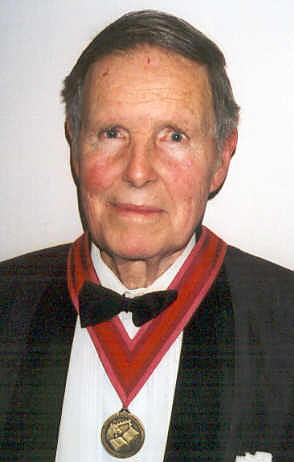 William Craig of Hobart has been a student of the often-neglected field of Revenue Stamps over a lifetime. While collecting revenues was popular in the late 19th Century, their popularity diminished in the 20th century, largely due to the lack of easily available catalogues and information; a dearth which particular affected Australian States and Commonwealth post-1901 issues.
William Craig of Hobart has been a student of the often-neglected field of Revenue Stamps over a lifetime. While collecting revenues was popular in the late 19th Century, their popularity diminished in the 20th century, largely due to the lack of easily available catalogues and information; a dearth which particular affected Australian States and Commonwealth post-1901 issues.
Bill Craig was instrumental in compiling, editing and publishing, personally, and in conjunction with others, comprehensive listings for the Commonwealth and Australian States Revenue stamps.
The first of these, for Tasmania, was published in 1978 and the last for Victoria, in 1999. These annotated catalogues, for all states [except Western Australia], Australian Territories and the Commonwealth, incorporated much information, particularly on the post-1910 issues that had not previously been listed in any publication.
Printed and published by Bill Craig, as ‘Revenue and Railstamp Publications’, the publications appear on lists of all retailers of revenues literature worldwide. Bill’s editorship, contributions and publications of various State listings were not driven by profit, but simply to further the collecting interest in Australian States’ revenue stamps.
The impressive list of Bill’s publications includes:
The Revenue and Railway Stamps of Tasmania with Owen Ingles in 1978
The Revenue Stamps of Queensland in 1982;
The Revenue Stamps of N.S.W with D Osborn and Tony Orchard in 1983
The Revenue Stamps of the Commonwealth of Australian and its Territories with others, in 1986;
The Revenue Stamps of South Australia with Tony Presgrave and Martin Walker in 1993;
Handbook of Tasmanian Revenue Stamps – an update of the earlier publication in 1997
Handbook of Victorian Revenues in 1999
The Revenue Stamps of the Commonwealth of Australia and its Territories – an update in 2002
Handbook of Tasmanian Revenue Stamps – an update in 2002
The listings have been of enormous benefit to the collectors of Australian revenues, becoming the standard listings for collectors, judges and dealers alike.
The contribution of Bill Craig over the past 30 years to the collecting and exhibiting of Australian States and Commonwealth revenues has been immense. It far exceeds the contributions of any other philatelist in this field.
( Source: APF News, July 2003 )
Anthony (Tony) Dean Presgrave – Research
Tony Presgrave of Goolwa, South Australia commenced serious specialized collecting of the Australian Commonwealth in 1970. His collection of the Travelling Post Offices of South Australia became an original research collection which formed the basis of his book The Travelling Post Offices of South Australia published by the Stuart Rossiter Trust. This work has been awarded a Vermeil medal at FIAP level [Hong Kong 2001].
Also formed in the early 1970s, was a collection of the Railway Parcel Stamps of the Australian States and Commonwealth. Tony’s knowledge and research of this subject led to his joint authorship of the publication, The Railway Stamp of Australia.
Tony’s collection of The Departmental Stamps of South Australia which has been awarded an FIP Large Vermeil medal at Australia 99 was the basis of the publication The Departmental Stamps of South Australia of which he was author. He was also the author of the publication Albury Postal Services.
Tony is a prolific writer and contributor of philatelic journals and magazines. He has written on many philatelic subjects relating to South Australia and also Railway Parcel Stamps. He was the first editor, and now, joint editor of The Shilling Violet [journal of the South Australian Study Group of Philatelic Society of South Australia]; is editor of Cinderellas Australia magazine and editor of Cinderella Corner in Stamp News. He is also Past editor of Stamp Talk, journal of the Philatelic Society of South Australia
Carl Stieg – Research

Carl Steig (R) and Bernard Beston APF (R)
Carl Stieg, of San Rafael, California USA, has devoted a lifetime of philatelic interest, study and research to the area of Australian States postal stationery. He is a widely acknowledged authority in this area, and his investigative and original research which has been published in a wide range of philatelic journals over several decades, has contributed enormously to the sum of knowledge on Australian postal stationery in the colonial period.
Articles on subjects as diverse as States’ Official Postcards, Registered and Printed-to-Private-Order envelopes have been printed in journals such as Australian Chit Chat, The SPA Journal, Oceania, Postal Stationery, Philately from Australia and The Informer , and bear testament to Carl’s original and significant research.In the year 2001, Carl Stieg’s valuable contribution to research in the area of Australian philately, culminated in the publication of the definitive work on Victoria, ‘Victoria Postal Stationery, 1869-1917’.
Left: On 26 April at the 2003 WESTPEX Exhibition held in San Francisco, APF Past President Bernard Beston presented Ret. Col. Carl Stieg with his APR award. The presentation was made at the WESTPEX Awards Ceremony prior to the exhibition awards being made. Up to 200 fellow philatelists were present to see Carl receive his award. Carl responded to Bernard’s presentation with a few words on how privileged he was to receive the award and how he held Australian philately dear to his heart.
Postscript
Carl Stieg passed away in January 2010 .
Ken Sparks, Research
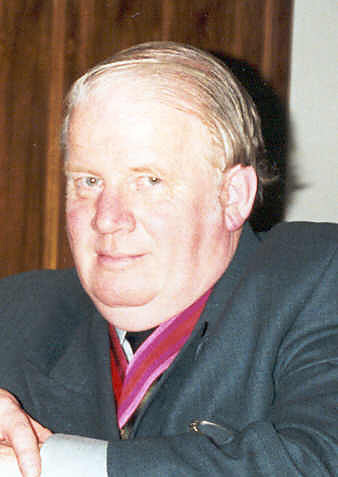 In any overview of philatelic literature, Kenneth Sparks is noted as one of the chief recorders of modern postal services, to this should be added his work with postal technology as well as his efforts in philatelic publishing both on paper and electronically.Ken came to philately with a background in engineering. His monograph on Framas assisted in getting him a position in Australia Post Engineering. Throughout the 1980’s Ken and others regularly recorded what was happening with Australia Post’s coin in the slot vending machines. Ken also collected and researched Australia’s first major effort in computerised mail sorting, the Redfern Mail Exchange. From this was produced Postal Mechanisation in Australia – A Brief History which ran to several editions as new technologies were introduced.
In any overview of philatelic literature, Kenneth Sparks is noted as one of the chief recorders of modern postal services, to this should be added his work with postal technology as well as his efforts in philatelic publishing both on paper and electronically.Ken came to philately with a background in engineering. His monograph on Framas assisted in getting him a position in Australia Post Engineering. Throughout the 1980’s Ken and others regularly recorded what was happening with Australia Post’s coin in the slot vending machines. Ken also collected and researched Australia’s first major effort in computerised mail sorting, the Redfern Mail Exchange. From this was produced Postal Mechanisation in Australia – A Brief History which ran to several editions as new technologies were introduced.
In the early 1990’s Ken helped establish a publishing house to produce small quantity, good quality, philatelic works with emphasis on the modern era. During this time he researched, wrote and published:
Official airmails of Australia
Bass Strait mails
Australian postal vending machines
Australian street posting boxes
Working within Australia Post allowed Ken to access some data which would not be generally available.
Ken contributed columns on contemporary philatelic happenings, to both Australian Stamp Monthly and Stamp News Australia. In the early 1990’s he also edited and published his own monthly newsletter emphasising postal mechanisation – Modern Philately.
He currently edits a postal technology column on Australia’s only electronic stamp magazine Stamps au.
His research interests have also translated into collecting interest which in turn led to his exhibit on Australian Postal Technology which concentrated on the introduction of electronic mail sorting at Redfern through to Letter Indexing Desks which signalled the next generation in this area. This and his work in publications has been recognised at Australian National Philatelic Exhibitions. Geoffrey Kellow, in 2000, wrote “It is often said, with great justification, that the best time to document postal history is when it is current. The research of Ken Sparks has followed this axiom “
( Source: APF News, June 2000 )
J P (Perc) Meara, Research
Perc Meara was one of the first philatelists to undertake a systematic study of post-1937 recess-printed stamp issues of the Australian Commonwealth. These stamps, produced using new technology, required very careful and minute examination in order to reveal the techniques used in their manufacture. Perc was a leader in this field right into the 1970’s, much of his earlier work being undertaken with Chas Dunn. Much of our knowledge of this period comes from the observations made by Perc of these stamps when they were current. It is no coincidence that many of the dates for the recorded changes of paper, perforation and plate layout are those of first sightings in Brisbane.
The results of this research was publicised in Philately from Australia, the Bulletin of the Australian Commonwealth Collectors Club of NSW, and the Bulletin of the Australian Commonwealth Specialists’ Society of Great Britain (now the British Society of Australian Philately). Most of these articles remain the most important source of information available on the subjects treated. Indeed an article entitled “Laying down the Australian Master Plate” published in 1958, is probably the single most important article on Australian Commonwealth philately ever written. He formed a very important research collection of Australian stamps 1937-1970 on which much of his research was based.
Despite this body of work, Perc is best known as the editor of the Australian Commonwealth Specialists’ Catalogue from 1965 to 1982, and under his guidance this already well-established catalogue was maintained and continually improved.
Best he be though of as a “stamp man” Perc worked for the Queensland Railways, and this engendered an interest in the carriage of mails by rail. He produced one monograph and a number of articles on this theme.
[ Source: APF News, October 1999 ]
Postscript
Perc passed away in Brisbane on 13 January 2004.
Tony Orchard, Research
Dr. Tony Orchard is a prolific writer on philatelic matters in magazines and journals and has published an impressive list of books on diverse philatelic subjects. This work is supported by collections and an exhibit of Maritime Mails of Sydney which has been awarded vermeil at Stampex 86 and Stampshow 91 and large vermeil at Wapex 93.
Perhaps his most public face is as the columnist ‘First Impressions’, a 2000 word column on postmarks and associated matters written for Stamp News from 1988 to 1997. Also published in that magazine were regular columns on ‘Journal Reviews’ and ‘Research Reports’ from 1989 to 1997.
He has been responsible for the publication of an impressive list of books in conjunction with other editors and in his own right. Many of these books studied in depth the postmarks of all aspects of the postal service of Sydney and he was also responsible for important sections of the classic work on the Postal history of New South Wales published in 1988. Many of his works were prepared in collaboration with other students of postal markings such as Robert Tobin APR and Robin Occleshaw. Most of these works were published under the banner of Magpie Publications, set up by Tony to produce such works.
In 1992 he began a series of books on the Tasmanian Postal Acts and Regulations which made available many official documents on the postal service in Tasmania under the one series tied by expert commentary by the author. He has managed to produce a philatelic book in all but one year between 1986 and 1999.
His pen has been equally active in the production of articles for philatelic journals over the past seventeen years. These have been published in Philately from Australia, Sydney Views and The Courier. The subjects have been principally on postmark studies and postal history. He has also edited several Exhibition catalogues for exhibitions in Tasmania and the ACT.
He has been editor of the journal of the Tasmanian Philatelic Society titled ‘The Courier’ since it’s inception in 1988 with only two small breaks. He is also a National judge qualified in the postal history discipline.
There is no doubt that Tony has been and continues to be one of Australia’s most prolific philatelic writers.
(Source: APF News, October 1999 )
Richard Breckon – Research
 Richard Breckon’s most significant research interests have been in Australian postal history, airmails and Victorian postal stationery.
Richard Breckon’s most significant research interests have been in Australian postal history, airmails and Victorian postal stationery.
The articles on Australian Commonwealth Postal Rates 1901-1966, which were published in The Australian Philatelist and subsequently, in revised format, as part of The Australian Commonwealth Specialists Catalogue, are probably the most used and most quoted series to be published in this country in modern times.
Richard’s articles on modern Australian stamps, based in part on his insights during his time at Australia Post, have placed on record many aspects of their history which otherwise may have been lost. His writings on Victorian postal stationery, based on archival researches and backed up by the formation of a significant collection, were eventually published as part of The Stamps of Victoria in 1990.
(Source: APF News, October 1998 )
Robert Tobin, Research
 Robert Tobin represents the invaluable work produced by rural and regional collectors on behalf of Australian philately.
Robert Tobin represents the invaluable work produced by rural and regional collectors on behalf of Australian philately.
Living in Narrabri meant long journeys to undertake research of collections, official records and archives. Working mainly in marcophily, Robert Tobin has also extended his research into main stream postal history. He is the author of The Postmarks of New South Wales Vol 1and also collaborated with Norman Hopson to produce The Post Offices and Postmarks of ACT and NSW and Tony Orchard in the production of a series of three volumes on the postal history of Sydney. Mr Tobin’s work on postmark types was used extensively in The Postal History of New South Wales 1788-1901, for which he was listed as a co-author.
He has also been a long term contributor to many philatelic journals, including articles on early Australian internal and international airmails. He exemplifies a group of researchers who have made extensive use of archival and Governmental records, which has greatly improved the understanding of Australian philately in the areas of postal history.
(Source: APF News, October 1998 )
Hugh Campbell, RDP, FRPS.L – Research (1914 – 2002)
 Hugh Campbell epitomizes the very concept of the Australian Philatelic Order Research Award. His more than 50 years in the hobby have been directed almost entirely to books and research. He was founding Editor of Philately from Australia, for a short time Society Librarian and the sole remaining inaugural member of the Royal Philatelic Society of Victoria, Publications Committee, when philatelic publishing was commenced in 1950, all of which reflect his strong interest in, plus the development and support, of philatelic literature.
Hugh Campbell epitomizes the very concept of the Australian Philatelic Order Research Award. His more than 50 years in the hobby have been directed almost entirely to books and research. He was founding Editor of Philately from Australia, for a short time Society Librarian and the sole remaining inaugural member of the Royal Philatelic Society of Victoria, Publications Committee, when philatelic publishing was commenced in 1950, all of which reflect his strong interest in, plus the development and support, of philatelic literature.
As a notable author, his studies have mainly been in the fields of postal history, postal rates and routes, the first of which was “Fiji – The Post Offices and Postal Cancellations” which was published just 40 years ago.
In the following years his interest turned to the Australian Colonies where he wrote major studies on the postal markings of New South Wales, Queensland, South Australia and Tasmania (the latter as General Editor) most of which were in the pioneer field and although published over several decades, a large proportion of the Hugh Campbell works, remain the accepted authority on their respective subjects.
He has had an enormous number of articles published in Philately from Australia, The London Philatelist and other world-wide journals.
Hugh was invited to sign the Roll of Distinguished Philatelists in 1969, the significance of his literary skills, was a strong point in this achievement.
(Source: APF News, October 1997 )
Postscript
Hugh passed away on 5 July 2002 at the age of 87.
Dr Geoffrey N Kellow – Research
 Dr Geoffrey Neil Kellow B Sc (Hons) Ph D, was born in July 1953. He joined the Royal Philatelic Society of Victoria in 1975, and was awarded the JRW Purves Medal for services to the Society in 1990. He has been Librarian of the Society since 1976, apart from three years absence in Sydney, and has been editor of Philately from Australia since 1981.
Dr Geoffrey Neil Kellow B Sc (Hons) Ph D, was born in July 1953. He joined the Royal Philatelic Society of Victoria in 1975, and was awarded the JRW Purves Medal for services to the Society in 1990. He has been Librarian of the Society since 1976, apart from three years absence in Sydney, and has been editor of Philately from Australia since 1981.
Geoff joined the Royal Philatelic Society, London in 1982, and was elected Fellow in 1995. He and Peter Jaffe were awarded the Tapling Medal in 1989, for their article, “The Saint Vincent 4d on one shilling provisional of 1881”, published in the “London Philatelist” in 1988.
In addition to his many published books on Australian and Victorian philately, Geoff’s articles, from 1980 onwards add up to a formidable total, the titles covering several pages. They are to be found in Philately from Australia, The London Philatelist, Sydney Views, Australian Commonwealth Collectors Club of NSW Bulletin, The Australian Philatelist and The Australian Philatelic Yearbook, 1991.
(Source: APF News, October 1997 )
Brian Pope
Brian Pope was a foundation member of the Western Australian Study Group in 1974, and has supported / assisted research of the postal history, as well as having major research studies published on various aspects of that State. He has published many books on Western Australian philately, the latest being Western Australia: The Forces, Prisoners of War and Censor Mail (1997) co-authored with Brian Haynes.
Over the 20 years of his research many articles have been published in the Black Swan (Western Australian Study Group journal of which he is currently editor) as well as in Philately from Australia and Sydney Views.
Brian’s research work has been published for study by other philatelists and provides new information of significant nature or reassessment of known data and has greatly extended the knowledge of the philately of Western Australia.
ED WILLIAMS Research
Edward Alexander Williams was born and brought up in the United States. He came to Australia in 1941 and taught under the late Sir James Darling at Geelong Grammar School. After WWII, he returned to the United States.
As a member of the Society of Australasian Specialists, Ed was well known to philatelists in America, but he was not so well known in Australia until the publication of Northern Territory: A Postal History 1824-1975, published under the authorship of E Williams and P Collas by the Society of Australasian Specialists in 1977.
Phil Collas died in 1989, but Ed Williams continued his work on the Northern Territory, which resulted in his The Postal History of the Northern Territory, 1824-1988, which was published in 1992, a much enlarged edition of the earlier work. Ed wrote three Supplements to this book, which were published in Philately from Australia, the first in three issues in 1993, the others in December 1994 and June 1996.
As a member of the Australian States Study Group of the Royal Philatelic Society, London, he has contributed to the Group’s newsletter, his comments on such diverse subjects as the Zieher Postcards Illustrating Stamps, South Australian Railway parcel Stamps, Queensland Private Perfins and Forgeries of Australian States Stamps.
Currently he has a manuscript on the South Australian Postage and Revenue Long Stamps, at the proof stage which will be published by the Royal Philatelic Society of Victoria later this year(1997).
